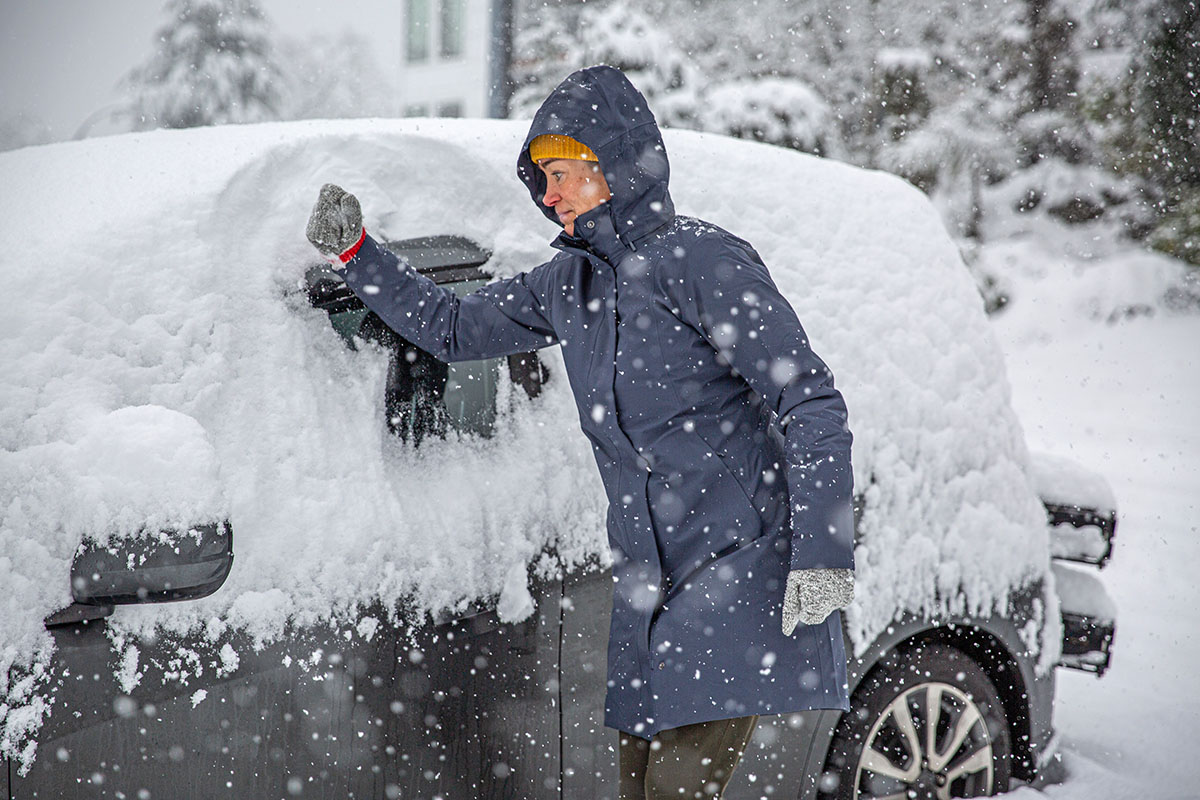

When the days get shorter and the mercury drops, it’s time to reach for a winter jacket to guard against the cold. Lightweight puffies have their place for three-season use, but you'll want a well-insulated, serious piece for truly frigid conditions. The women's jackets and parkas here are among the warmest available and use down (and sometimes synthetic) insulation and tightly woven shell fabrics to trap warmth and resist howling winds. Below are our top picks for 2025, including everything from casual mid-thigh parkas to performance-oriented puffies and expedition-grade jackets. For more background information, see our comparison table and buying advice below the picks, along with details about our testing process.
Editor's note: We updated this guide on February 25, 2025, to add three new models from Paka, Kühl, and Arc'teryx, as well as to remove discontinued jackets, add new photos and findings from testing, and ensure that all links, prices, and colorways were current at the time of publishing.
 Fill: 8.5 oz. of recycled 600-fill-power down
Fill: 8.5 oz. of recycled 600-fill-power down
Center back length: 39.3 in.
Waterproof?: No
What we like: Patagonia's performance and quality in a cozy and stylish parka.
What we don’t: Average-quality down and bulky packed size.
For everyday activities like running errands, dropping the kids off at school, or taking a walk around the block, it’s hard to beat the warmth and styling of a down parka. Patagonia’s Down With It Parka stands out for its combination of premium build quality, attractive colorways and finishes, and thoughtful feature set, including a two-way front zip (vital for a parka if you'll be riding a bike or sitting) and a removable hood. For insulation, you get a generous 8.5 ounces of 100%-recycled 600-fill down—enough warmth for all but the most frigid winter conditions—and an extra-long (39.3-in.) center back length. All told, it’s no secret why the Down With It Parka has become one of the most well-loved winter jackets year after year.
The Down With It sounds great on paper, but its comfort is what won us over in the end. The interior is silky smooth, and the parka has a barely-there feel that’s a far cry from designs with thick, canvas-like exteriors (like The North Face's Arctic Parka or Fjallraven's Nuuk below). We also love the flattering fit, which offers just enough tapering at the waist to create shape. But there are a couple shortcomings. For one, the 600-fill down doesn’t offer as much warmth for weight as jackets with higher-quality fill (the higher the fill number, the loftier the down), but this should be of little concern to most casual users. Second, while the PFAS-free durable water-repellent (DWR) finish resists light moisture, the Down With It is by no means a waterproof jacket like Patagonia's own Tres below. But it’s all you need for dry or sub-freezing conditions, and Patagonia’s polished fit and finish are hard to beat. For those who don’t need the below-the-waist coverage, the Down With It also comes in a hip-length version for $229.
Read more: Patagonia Down With It Parka review (prior version)
See the Patagonia Down With It Parka

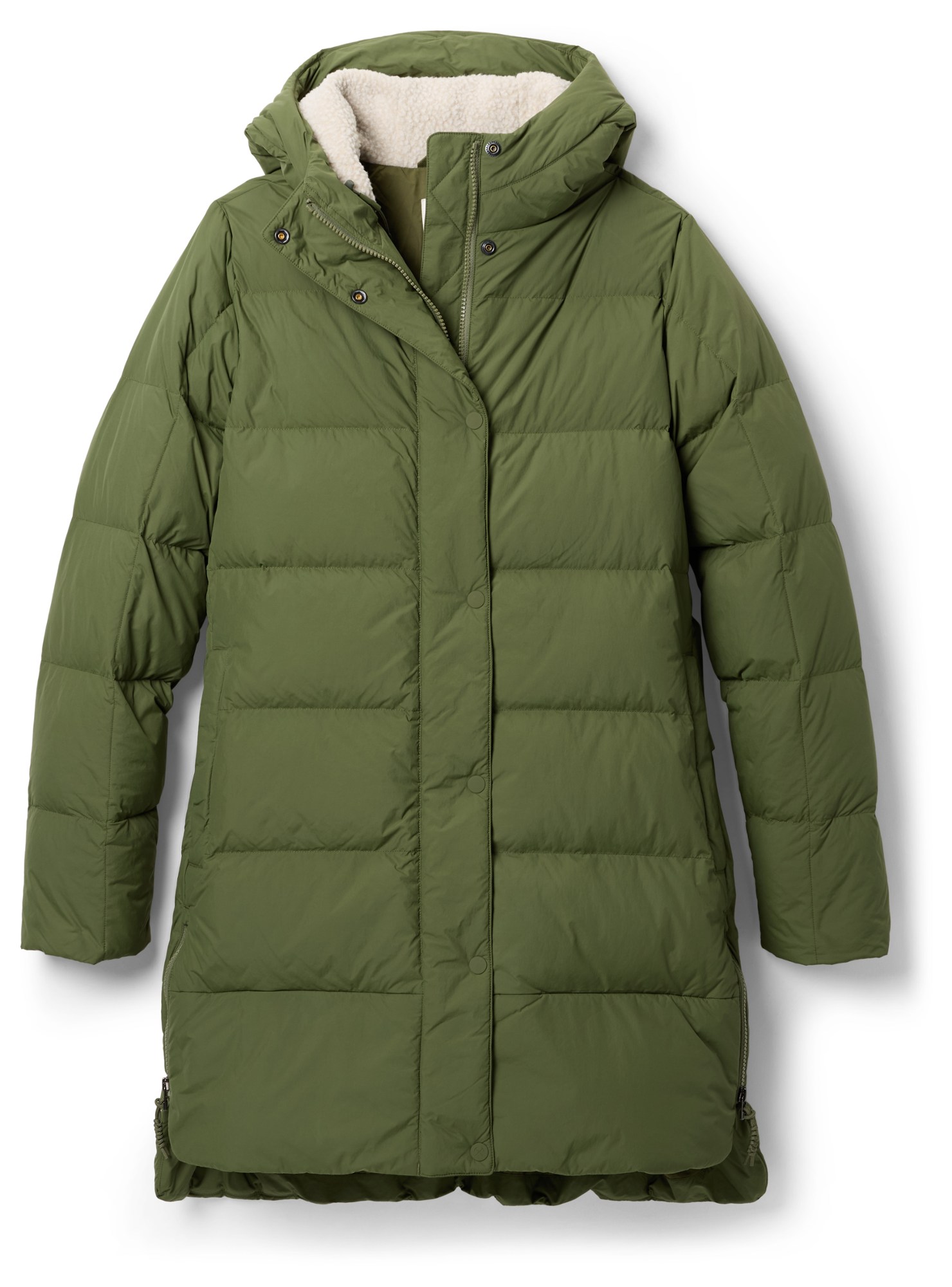 Fill: 650-fill-power down; 120g synthetic
Fill: 650-fill-power down; 120g synthetic
Center back length: 36.5 in.
Waterproof?: No
What we like: A warm and stylish down parka for just $229.
What we don’t: Boxier than most parka-length jackets.
REI Co-op is known for making quality gear that considerably undercuts the competition, and their winter-ready Norseland Down Parka follows suit. At just $229, REI's down parka saves you around $100 (or more) compared to similar jackets without sacrificing much in the way of performance. In terms of specs, you get mid-range, 80%-recycled 650-fill down (even loftier than the insulation in our top-ranked Down With It), a DWR-coated shell, and additional features like a fleece-lined hood, stylish knit cuffs, and an insulated storm flap over the front zipper. REI even included synthetic insulation along the lower body and hood opening, which provides a nice dose of added assurance in wet weather (unlike down, synthetic fill will continue to insulate when wet).
REI updated the Norseland last year, with key changes including a more weather-resistant shell and a PFAS-free DWR coating that forgoes the use of harmful “forever chemicals.” This upped the price a bit over the previous version, but we think the updates only add to the all-around appeal and still consider the Norseland to be a stellar value for what you get. It’s true that this parka has a bit of a boxy cut compared to the more flattering, tailored fits you get with jackets like the Down With It above or Marmot Montreal below, but it’s still a good-looking everyday piece. And we love that the Norseland has side zips, which extend 6 inches up each side to allow for better freedom of movement while sitting, walking, or biking (they also provide venting should you work up a sweat). Added up, the Norseland is a competitive option for value seekers and those who don't mind the roomier shape.
See the REI Co-op Norseland Down Parka
 Fill: 5.6 oz. of recycled 700-fill-power down
Fill: 5.6 oz. of recycled 700-fill-power down
Center back length: 35.5 in.
Waterproof?: Yes
What we like: Waterproof protection and the option to add or subtract warmth.
What we don’t: Expensive.
Not everyone needs a waterproof winter jacket, especially in regions where winter weather is particularly dry or cold. But for mild and wet conditions (we’re looking at you, PNW), a waterproof shell can make a world of difference in staying comfortable all season long. Within this category, we’re big fans of the 3-in-1 style: Wear the insulated layer on cold and dry days, don the waterproof shell in rain, and pair both for protection against the most wintery of weather. Patagonia’s Tres 3-in-1 is a runaway favorite, with a 2-layer waterproof shell (now with a PFAS-free DWR finish) and moderately insulated down jacket on the inside. Tack on Patagonia’s typical good looks and top-notch build quality, and the Tres is a well-made and attractive design for moderate winter temperatures and drippy conditions.
What are the downsides of the Patagonia Tres? First and foremost, it’s pricey at $699, even considering the versatility of the 3-in-1 design. In addition, the liner isn’t super warm with just 5.6 ounces of 700-fill down, although the Tres is perfectly suitable for temperatures around freezing or a bit below. And last but not least, fit can be tricky with parkas—and particularly with 3-in-1 designs, given all the moving parts—although the latest version of the Tres was updated from a slim cut to a more versatile regular fit with a classy drop-tail hem. All told, we love the package deal and the option to easily tailor your layering depending on conditions, which is why we have the 3-in-1 ranked here. For a cheaper ($499) and lighter waterproof option from Patagonia, check out their Jackson Glacier Parka below, which offers comparable warmth but forgoes the removable down midlayer.
Read more: Patagonia Tres 3-in-1 review
See the Patagonia Tres 3-in-1 Parka

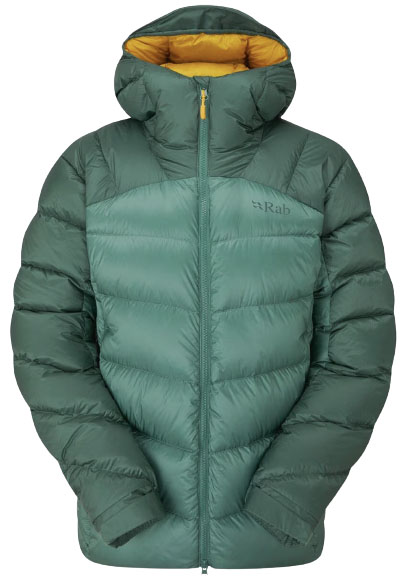 Fill: 7.5 oz. of 800-fill-power down
Fill: 7.5 oz. of 800-fill-power down
Center back length: 28.3 in.
Waterproof?: No
What we like: Lots of premium down for the price.
What we don’t: Fairly technical look and feature set.
The picks above are great for casual and around-town wear, but for more demanding backcountry pursuits, you'll want to consider a more technical offering. Taking warmth, features, and value into consideration, our favorite option for 2025 is Rab's Neutrino Pro. First and foremost, you get a whopping 7.5 ounces of 800-fill hydrophobic down, which is considerably more bang for your buck than popular down jackets from brands like Arc’teryx and Patagonia. The Rab also sports a water-resistant Pertex Quantum Pro shell with a DWR finish that offers far better wet-weather protection than most down puffies, along with functional extras like a wire-brimmed hood and adjustments at the hood, hem, and cuffs.
All that said, the Neutrino Pro isn't for everyone. The jacket has a decidedly technical look, although the clean design and darker colorways do help with overall appeal. Second, the 20-denier (D) shell fabric is respectable in the performance category and keeps weight low, but the jacket is more fragile than the casual options on this list (as with any down jacket, you’ll have to be careful about snags and tears). Finally, Rab is a U.K.-based company, and Americans will have to get used to the European-style left-hand zipper. But we love the warmth, feature set, and reasonable price point, which is why the Neutrino Pro remains a favorite year after year.
See the Rab Neutrino Pro
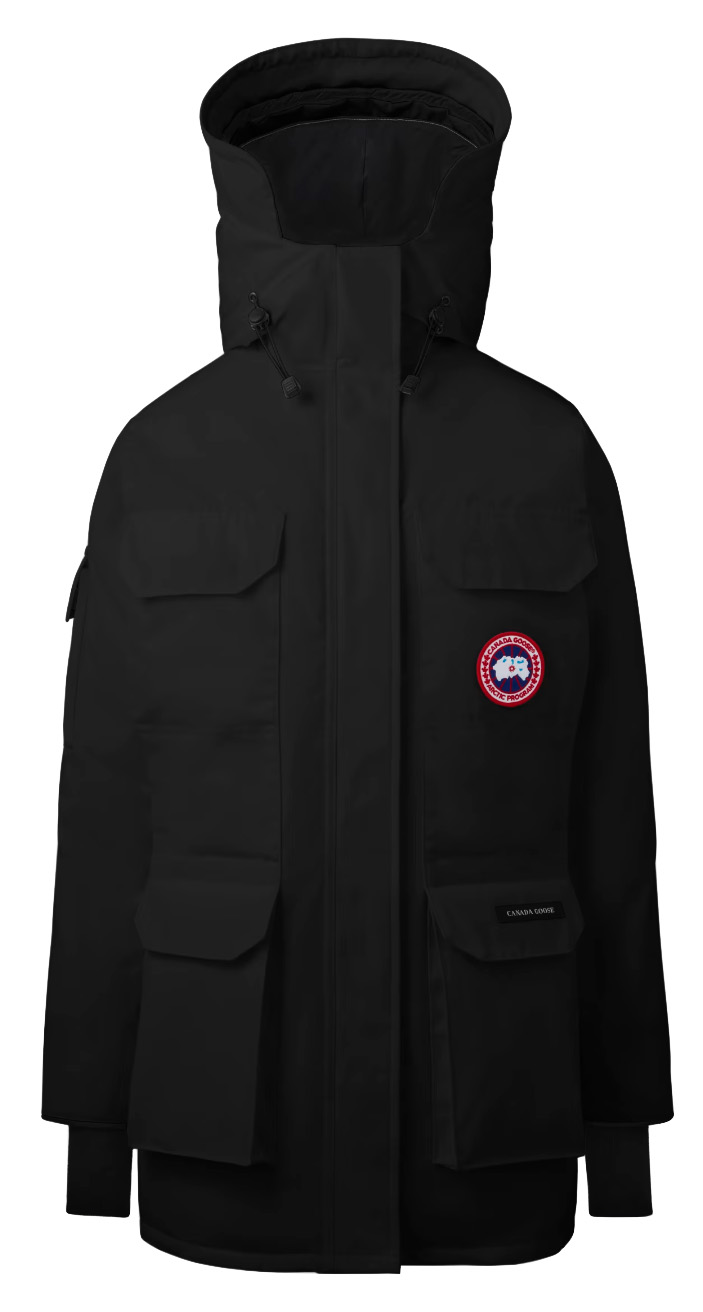 Fill: 625-fill-power down
Fill: 625-fill-power down
Center back length: 32 in.
Waterproof?: No
What we like: Stylish and rated for temperatures as low as -22 degrees Fahrenheit.
What we don’t: Extremely expensive and very heavy.
At the premium end of the spectrum is Toronto-based Canada Goose. These jackets are the real deal: They’re extremely warm, well-built, and downright fashionable. Originally developed for scientists working at McMurdo Station in Antarctica, the Expedition Parka is one of Canada Goose’s most formidable jackets and one of a select few to receive their “Extreme” temperature rating (-22 degrees Fahrenheit or lower). Features like a secure waist cinch, recessed cuffs, and elasticized snow skirt keep drafts at bay, while a water-resistant Arctic Tech shell surrounds the generous dose of 625-fill duck down (it’s ironic that the company uses mostly duck down and not goose). On the style side, a mid-thigh cut, durable shell, and drop-in utility pockets create an aesthetic that can play the part in Brooklyn or Breckenridge—you choose.
It’s hard to argue with Canada Goose’s awesome warmth, craftsmanship, and looks, but these do come at a price—in this case, it’s a staggering $1,675. In addition, prepare yourself to overheat in all but the coldest conditions. Canada Goose even includes built-in backpack straps that allow you to hang the jacket over your shoulders when not in use. And finally, the Expedition Parka is the heaviest and bulkiest offering here at almost 4.5 pounds, which can be a challenge for travel (you'll need a bigger suitcase) or during long stints on your feet. But if you run cold, need the extra insulation, or appreciate the styling, Canada Goose has a valuable corner of the market.
See the Canada Goose Expedition Parka
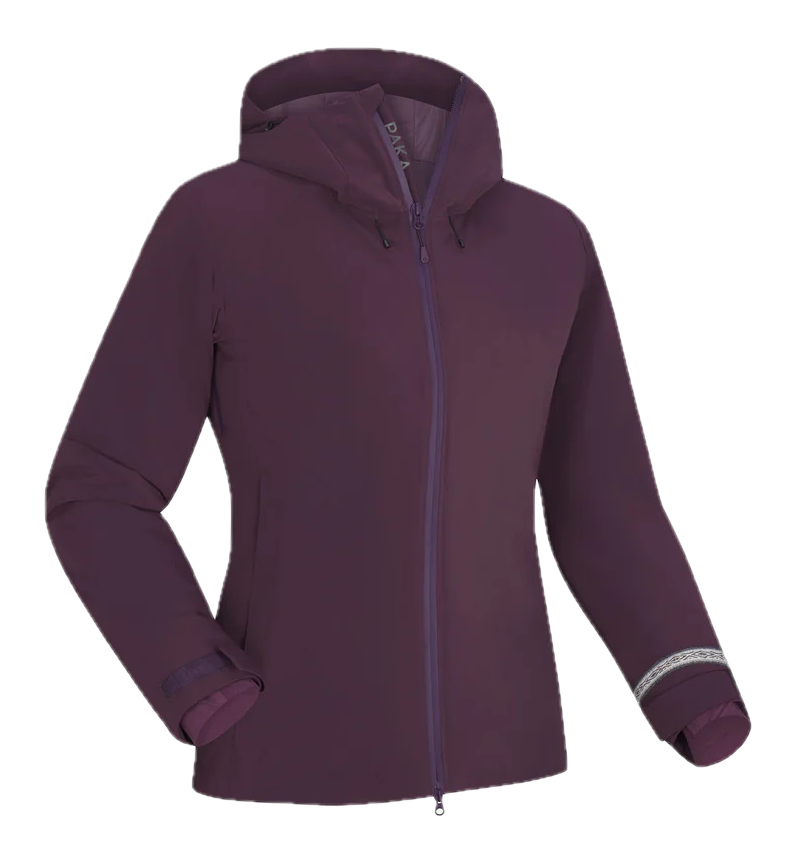 Fill: 130g & 110g Pakafill (alpaca fiber)
Fill: 130g & 110g Pakafill (alpaca fiber)
Center back length: 28 in.
Waterproof?: Yes
What we like: Incredibly soft exterior, lightweight, stylish, and practical features—all at a great price.
What we don’t: On the shorter side and not as compressible as a down puffy.
Year over year, there generally aren't huge changes in the winter jacket market, but the Paka Apu Parka is making a well-deserved splash. Don't be fooled by the almost-urban look of this stylish piece—it's got some major technical chops. From pit zips and a helmet-compatible hood to luxuriously soft interior cuffs with thumbholes and a shockingly supple waterproof exterior, the Apu is our favorite new jacket for the season. Paka won a coveted ISPO award for this parka, which uses their patent-pending and fully traceable "Pakafill" insulation sourced from free-roaming alpacas in Peru. If you cringe at the idea of down but also don't love the resources that go into synthetics, this jacket should be at the top of your list.
The Pakafill insulation in the Apu offers some of the perks of a synthetic design, namely less volume and the ability to insulate even when wet. That said, the overall build of this piece doesn't compress into a little ball the way a down puffy does. Still, at only 1 pound 10.1 ounces, the Apu is notably lighter than it looks at first glance. And while it doesn't provide as much coverage lengthwise as other pieces in our lineup, it's optimized for more technical pursuits (though classy enough for most any city-based excursion) and never felt too short in testing. With stylish branding elements like the decorative band around the wrist and warmth that belies the weight, we really enjoyed wearing this jacket and love the direction that Paka is taking. Another new offering from the brand that we're keen to try out is the Apu Lightweight Puffer.
See the Paka Apu Parka
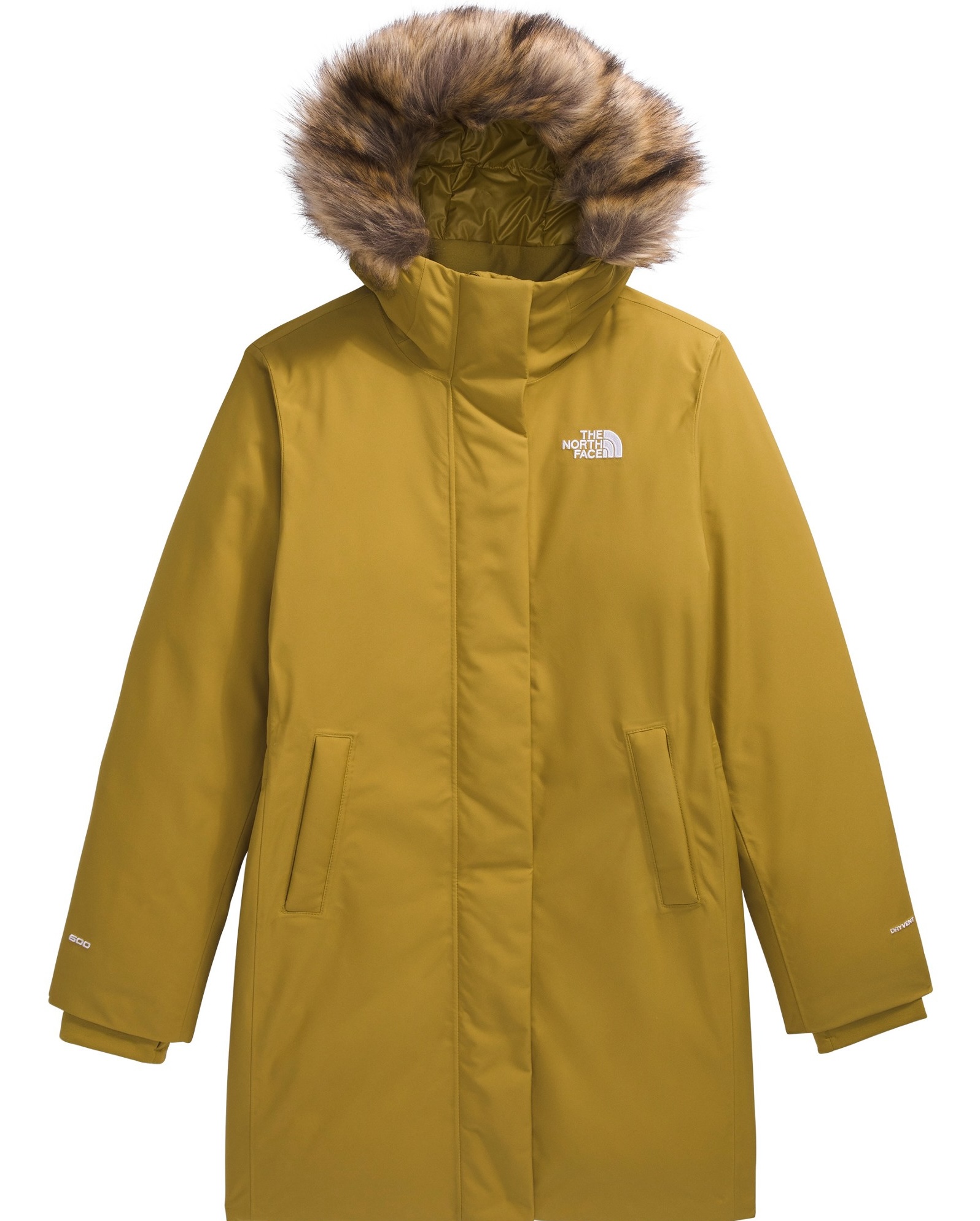 Fill: 600-fill-power recycled down
Fill: 600-fill-power recycled down
Center back length: 35.3 in.
Waterproof?: Yes
What we like: The warmth of down alongside a fully waterproof shell.
What we don’t: Heavy and has a boxy fit.
For affordable protection in whatever Mother Nature throws your way, we love the Arctic from The North Face. This parka is both nicely insulated and weather-ready, with 600-fill-power down (an upgrade from the previous version's 550-fill) wrapped in a 2-layer, waterproof DryVent shell that’s seam-sealed for added protection. The above-the-knee cut extends coverage down the legs without being too restrictive, and a removable faux-fur brim adds warmth and style. Added up, the Arctic is a nice value at $350, and we appreciate the use of recycled polyester and down—a nice reflection of TNF’s ongoing sustainability efforts.
But while the Arctic Parka is great for everyday use, it’s not a standout in versatility. Compared to the Neutrino Pro above, for example, it's considerably heavier and more restrictive. And held up against options like the Canada Goose Expedition Parka, you get a lot less warmth—in fact, despite its name, we don't recommend the Arctic for temperatures much below freezing. Finally, in terms of fit, we’ve found the Arctic to be slightly boxy from the waist down and recommend sizing up if you have broad shoulders. But these gripes aside, the Arctic is a nice option for those who need the waterproofing and are looking to keep costs relatively low.
See The North Face Arctic Parka
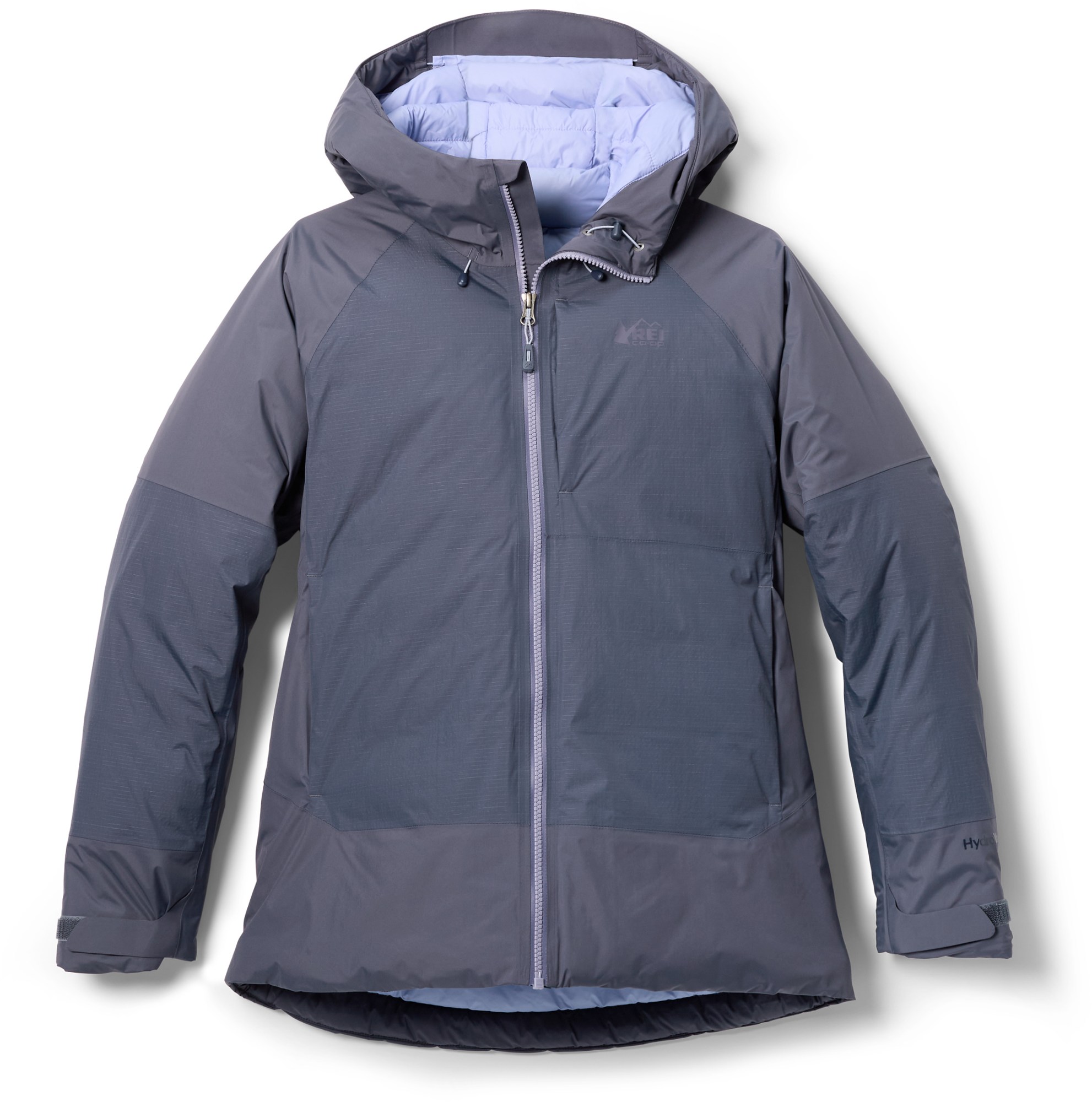 Fill: 850-fill down; 180g & 80g synthetic
Fill: 850-fill down; 180g & 80g synthetic
Center back length: 28.3 in.
Waterproof?: Yes
What we like: Great warmth and weather protection at an affordable price.
What we don’t: Not as warm or packable as performance options like the Neutrino Pro above.
Parkas have great casual appeal, and their warmth is unmatched, but we love the versatility and mobility of a standard-length winter jacket. More than most, the REI Stormhenge hits a great balance between everyday and performance use, coupling clean lines and classy colorways with a laundry list of technical features. In terms of warmth and weather protection, you get body-mapped 850-fill goose down, recycled synthetic insulation in areas prone to moisture and sweat, and a 2-layer waterproof shell. The Stormhenge also features a fully adjustable hood with a draft collar, Velcro cuffs, and pit zips to help vent if you start to overheat. The result is an insulating jacket that does a decent job keeping out weather and is ideal for drippy and cold conditions, even while on the move.
The Stormhenge received a sizable revamp a couple winters back, including a longer cut (by over 2 in.), more sustainably produced fabrics, two additional internal pockets (including a drop-in pocket for stashing gloves or climbing skins), and the aforementioned synthetic insulation. REI still doesn’t provide a fill-weight spec, but we’ve found the jacket to be warm into the low 20s Fahrenheit with only a light baselayer underneath. Of course, it’s important to have reasonable expectations when shopping from REI’s in-house collection, but the Stormhenge is impressively high-quality and well designed for the price. If you’re on the lookout for a jacket that can deliver equal parts weather protection and warmth, it’s well worth a look. Finally, REI also offers the Stormhenge in a parka-length version ($299) with a 36.5-inch center back length.
See the REI Stormhenge 850 Down Hybrid Jacket
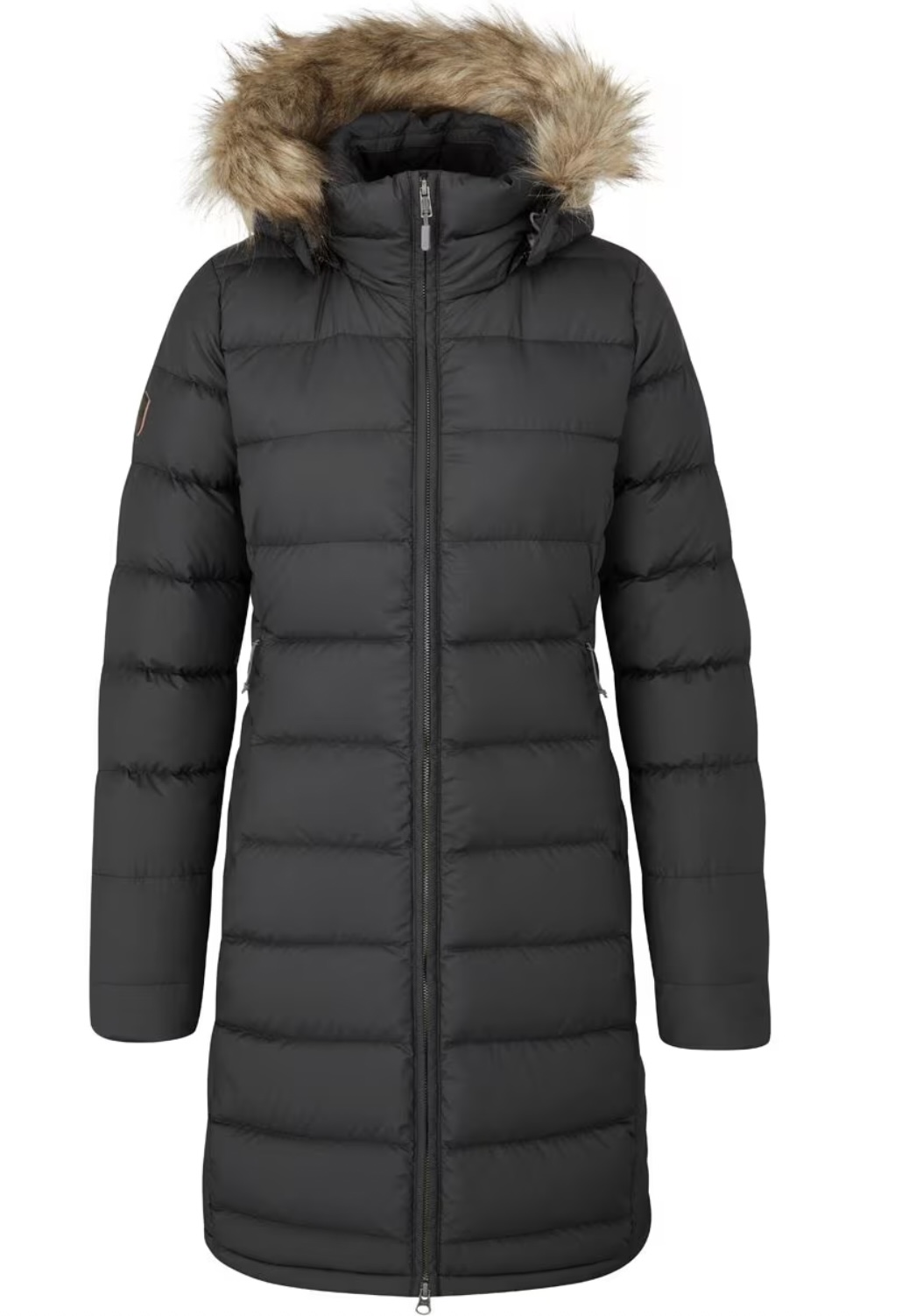 Fill: 12.0 oz. of 700-fill-power down
Fill: 12.0 oz. of 700-fill-power down
Center back length: 35.4 in.
Waterproof?: No
What we like: Great attention to detail, impressive warmth, and sustainably built.
What we don’t: Bulky and overkill for mild winter conditions.
Rab’s Neutrino Pro above is our top pick for activities like winter camping and ice climbing, but for everyday and around-town use, their Deep Cover Parka is a less technical and more stylish option. Packing in 12 ounces of 700-fill-power down (in a size large), the Deep Cover is built to handle true winter temperatures, whether you live in a mountain town or the heart of New York City. A 50D Pertex Quantum shell with a DWR finish and hydrophobic down add an extra dose of protection from moisture, and the hood is detachable and sports a faux-fur trim for style and warmth. Taken together, the $315 Deep Cover is an excellent value considering the level of protection and coverage.
The Deep Cover was lightly updated a couple winters ago, including changing to fully recycled materials and slightly higher-quality down. We love the classy leather zipper pull and badge on the right arm—similar to the previous model—and the chevron baffles on each side contribute to the flattering shape. And like many thigh-length parkas here, the Rab includes a two-way zipper to give you extra mobility and comfort when sitting down or high-stepping. Compared to the Outdoor Research Coze below, the Deep Cover packs about 4 ounces more insulation into a 7-inch-shorter jacket, which translates to noticeably more warmth. As a result, we don’t recommend the Rab for mild winters, but if you consistently face below-freezing temperatures—think January in places like Fairbanks, Fargo, or Edmonton—it’s a solid pick at a great price.
See the Rab Deep Cover Parka
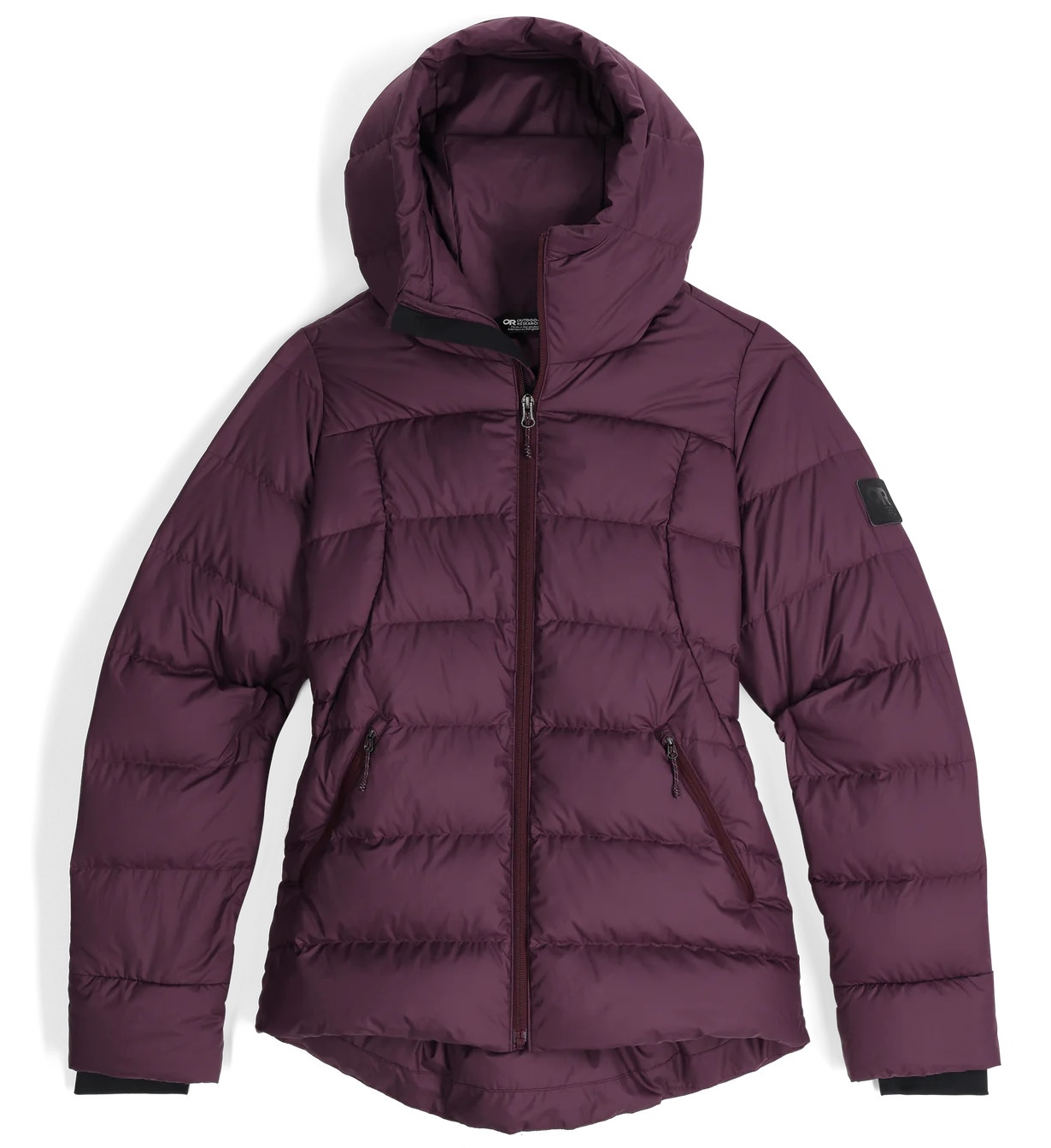 Fill: 5.6 oz. of 700-fill down; 150g VerticalX Eco
Fill: 5.6 oz. of 700-fill down; 150g VerticalX Eco
Center back length: 29.5 in.
Waterproof?: No
What we like: Comfortable, versatile, and affordably priced for what you get.
What we don’t: Not a standout in warmth or coverage.
Like REI, Outdoor Research is known for providing a lot of bang for your buck, and their Coldfront Down Hoodie does just that. For $279, the hip-length Coldfront offers a competitive mix of protection and warmth with weather-ready VerticalX Eco synthetic insulation at the shoulders and cuffs and quality 700-fill-power RDS (responsibly sourced) down everywhere else. In trying on the jacket for the first time, we were struck by the soft-yet-rugged shell and thoughtful touches like fleece lining in the hand pockets and snug-fitting cuff gaiters with thumb loops. All told, it’s a well-rounded choice for everyday use and outdoor adventuring in moderate winter conditions.
That said, it’s important to note that the Coldfront contains less down than some of our picks above, including the Down With It Jacket and performance-ready Neutrino Pro. It’s not exactly an apples-to-apples comparison given the differences in fill power, and the Coldfront certainly looks the part with its puffy build, but don’t expect Antarctic-ready warmth. Also, keep in mind that despite the generous hip-length style (the back length is 29.5 in.), there’s no below-the-butt coverage, which detracts from overall protection and won’t keep your legs warm like the longer parkas on our list. With the right layering, however, or if you plan to mix in hiking or snowshoeing, the Coldfront is a perfectly serviceable option with attractive styling that boosts its all-around appeal (you can wear it around town or in the backcountry).
See the Outdoor Research Coldfront
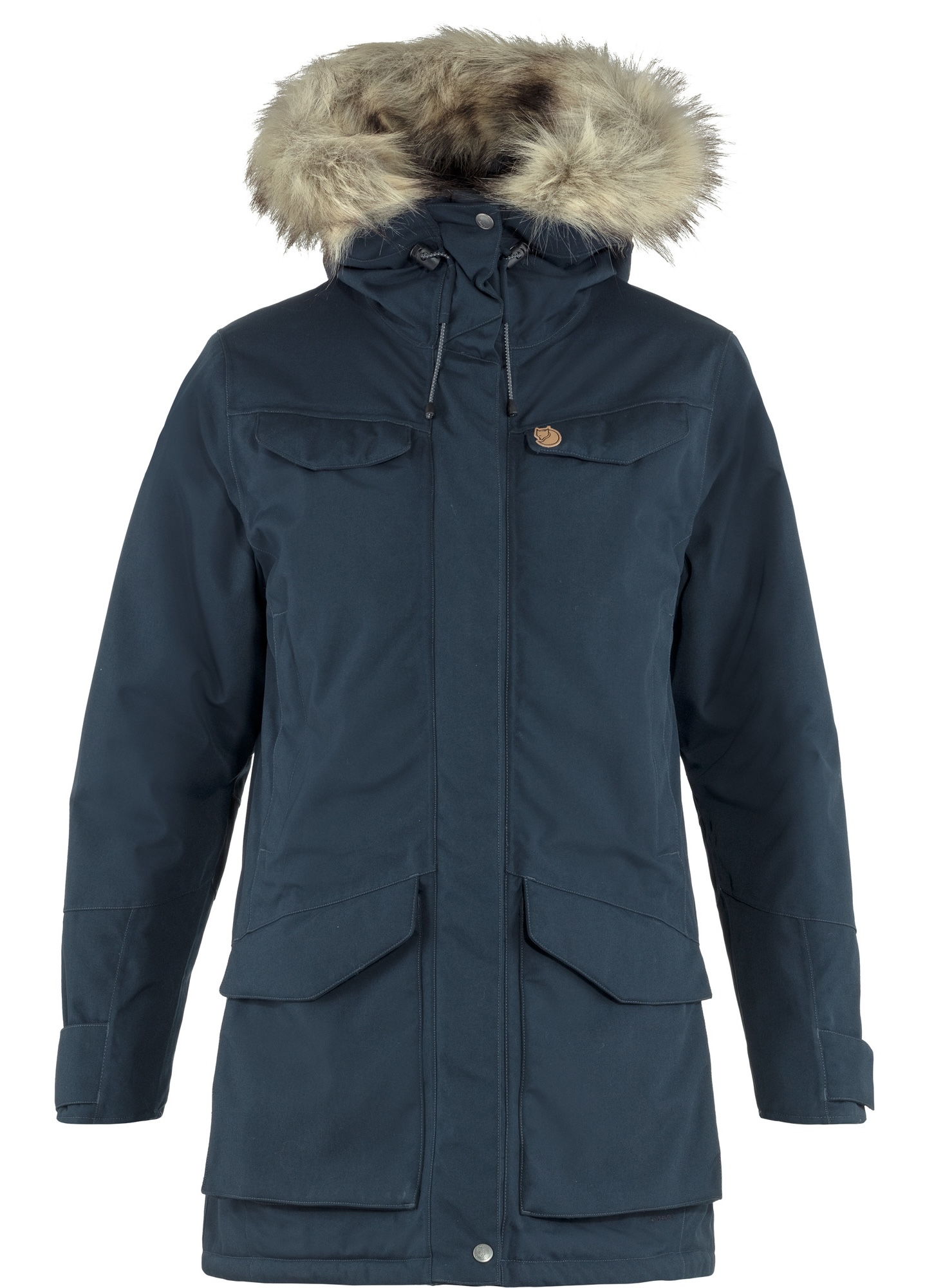 Fill: 250g Supreme Microloft synthetic
Fill: 250g Supreme Microloft synthetic
Center back length: 33.9 in.
Waterproof?: Yes
What we like: Good looks and excellent build quality.
What we don’t: Decidedly casual and pricey for a synthetic piece.
Similar to Canada Goose, Fjallraven makes good-looking outdoor gear that toes the line between casual and performance (at least casual levels of performance). The Nuuk Parka is a durable piece that offers excellent warmth and weather resistance with thick (250g) Supreme Microloft synthetic insulation, a water- and windproof outer shell, and clean lines representative of the company’s Scandinavian heritage. You also get a well-rounded assortment of storage and features, including a fleece-lined and fur-brimmed detachable hood, a whopping 11 total pockets, and ribbed knitting at the neck to seal out drafts. All in all, this is a refined, weather-ready winter parka with a high attention to detail.
If you like Fjallraven’s styling (we do) and don’t need the low weight or packability of down insulation, the Nuuk Parka is a fine option. That said, it’s too heavy and bulky to bring into the backcountry and lacks the lofty, cozy feel of down-stuffed alternatives like the Patagonia Down With It above. And for $500, the Nuuk doesn’t strike us as a particularly great value, costing considerably more than most other synthetic options (their Kiruna Padded Parka is cheaper at $350 but less warm and feature-rich). That said, the fashionable build and well-appointed design set the Nuuk apart from the rest of the market, and it definitely earned its chops in some serious weather during our testing.
Read more: Fjallraven Nuuk Parka review
See the Fjallraven Nuuk Parka
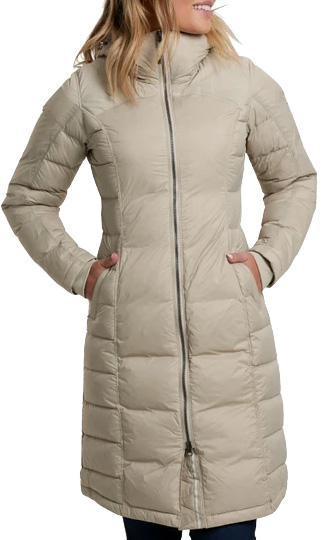 Fill: 10.1 oz. of 650-fill down & synthetic
Fill: 10.1 oz. of 650-fill down & synthetic
Center back length: 40 in.
Waterproof?: No
What we like: Great mobility, especially for the length; warm and fairly priced.
What we don’t: Sewn-through baffles detract from wind resistance, no interior storage, and fairly thin shell fabric.
The Kühl Crossfire is a reasonably priced parka with a lot to offer. It provides an excellent combination of length and warmth without feeling restrictive like many other long jackets, and the thoughtful tailoring keeps style high while still allowing for layering underneath. But what was most striking to us about the Crossfire is that, despite its 40-inch length (the longest on our list), it never felt restrictive, even when sitting or driving. It has a two-way front zipper (a pretty essential feature for a long parka), yet we never found ourselves needing to use it for basic around-town activities. The cuffs feature internal gaskets that are several inches long for added coverage, which—on top of the generous 10.1 ounces of 650-fill down and synthetic insulation—help seal out the cold, as do the tall collar and plush hood.
On the flip side, the Crossfire's warmth seems to come more from the amount of insulation than the quality. We tested this jacket in temperatures as low as -15 degrees Fahrenheit during a Montana winter, and it can't quite handle that level of cold. The sewn-through baffles allow frigid drafts to penetrate, and the thin (20D) face fabric strikes us as an odd choice for a long parka that likely isn't accompanying you on trips where weight and packability are primary concerns. Overall, we wish Kühl had used a thicker and more windproof construction, but the Crossfire has a lot going for it, and we've found ourselves reaching for it more often than expected this winter.
Read more: Kühl Crossfire Parka review
See the Kühl Crossfire Parka
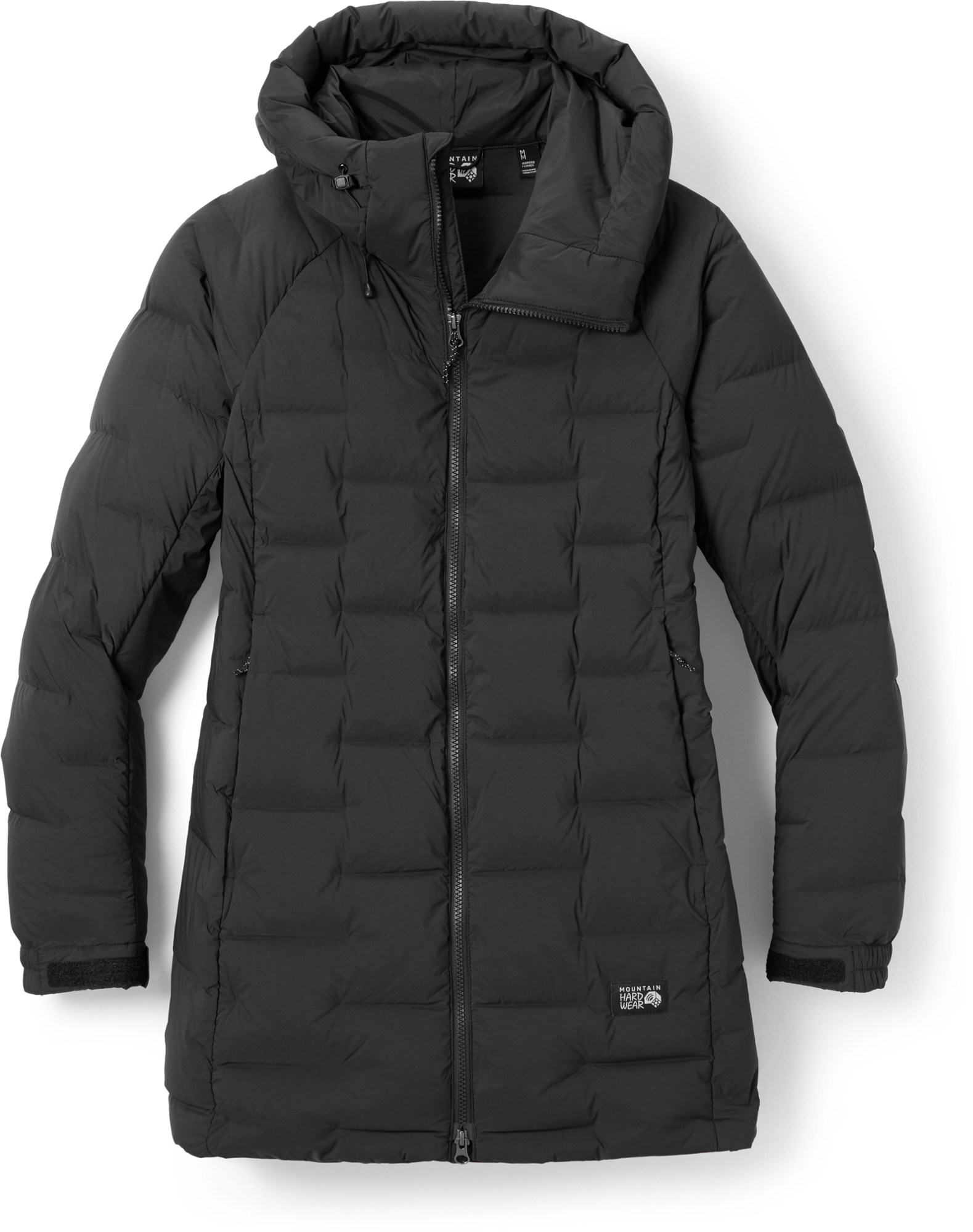 Fill: 700-fill-power down
Fill: 700-fill-power down
Center back length: 33 in.
Waterproof?: No
What we like: Attractive and versatile styling; shell fabric is stretchy and durable.
What we don’t: A bit shorter and boxier than most parkas.
Upon first glance, it’s easy to see that the Stretchdown Parka looks a little different from your standard down jacket. Instead of the typical shiny fabric and horizontal baffles, Mountain Hardwear uses welded seams and a stretchy material (hence the “Stretchdown”) that’s almost softshell-like in nature. The net result is comfortable down insulation that moves with you, is remarkably durable, and doesn’t leave you looking like the Michelin Man. The Stretchdown collection features a range of styles, and the Parka here delivers decent coverage and excellent warmth for true winter weather.
After wearing the Stretchdown Parka for most of the winter, we’re strong proponents of the jacket with a few small caveats. First is the shape: Compared to most parkas, it’s a bit short at just 33 inches and has no taper in the waist (though there is a Stretchdown Long Parka available for just $25 more that is 44 inches long). This no-frills fit makes the Stretchdown slightly more versatile for performance use (with a two-way front zip, it functions great over a climbing harness as a belay jacket) but will limit its street appeal for some. Second, it doesn’t offer quite as much warmth as heavyweight pieces like the Rab Deep Cover above. But we’re big fans of the versatile design, and it’s hard to beat the durability and hand feel of the soft and stretchy shell.
See the Mountain Hardwear Stretchdown Parka
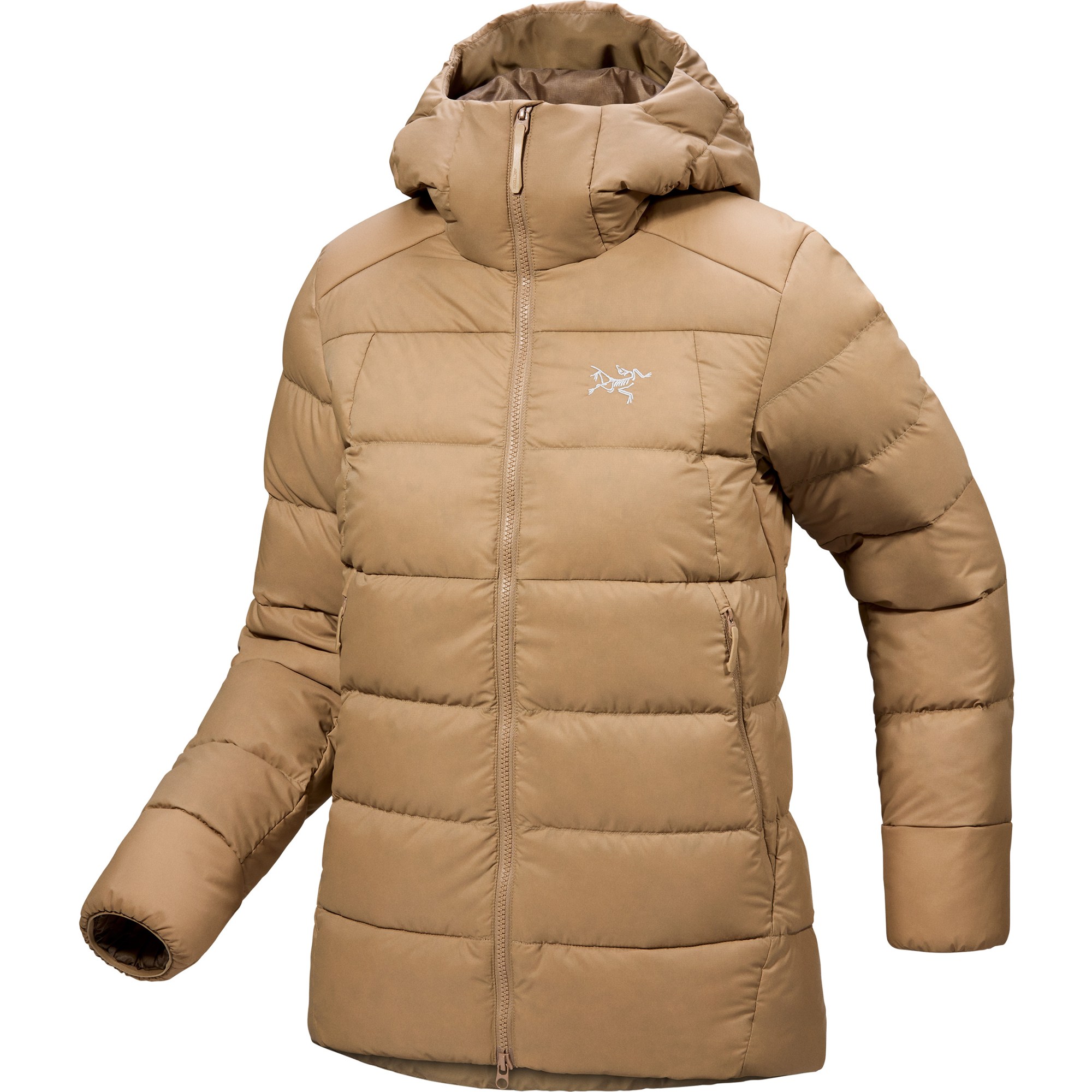 Fill: 5.0 oz. 750-fill down; 80g & 140g Coreloft
Fill: 5.0 oz. 750-fill down; 80g & 140g Coreloft
Center back length: 26.8 in.
Waterproof?: No
What we like: A versatile down puffy with Arc’teryx’s high-end build quality.
What we don’t: Expensive and not as warm or protective as the Rab Neutrino Pro above.
We’re a sucker for a cozy down puffy, and Arc’teryx’s Thorium Hoody is just about as good as it gets. Built for everyday winter use, the Thorium prioritizes durability over weight-savings with a relatively thick 30D shell that resists abrasion a lot better than more performance-oriented designs. The 750-fill-power down is perfectly serviceable for casual use (you simply don’t need any more packability), and the 26.8-inch hem offers a nice amount of below-the-waist coverage without being a full-fledged parka. Tack on wide, stylish baffles and a generous collar topped with Arc’teryx’s classic StormHood, and you’ve got one seriously nice midweight down jacket.
The Thorium is on the pricey side for a down jacket, especially considering that the OR Coldfront above offers similar warmth and protection for over $200 less. But it’s hard to beat Arc’teryx’s premium build quality, and the Thorium has a more feathery, lofty feel (and is over 5 oz. lighter). It’s also a Swiss Army Knife of a jacket: While we love the Arc’teryx for daily wear, features like an adjustable and helmet-compatible hood, internal dump pocket, and the added assurance of Coreloft synthetic insulation in exposed areas make it perfect for activities like backcountry skiing and winter climbing. All told, if you’re looking for a warm down jacket that can toe the line between the frontcountry and backcountry, the Thorium is without rival.
Read more: Arc'teryx Thorium Hoody review
See the Arc'teryx Thorium Hoody
 Fill: 8.2 oz. of recycled 700-fill-power down
Fill: 8.2 oz. of recycled 700-fill-power down
Center back length: 37.3 in.
Waterproof?: Yes
What we like: Great mix of style and performance with a recent boost in warmth and weather protection.
What we don’t: Price and weight went up with the latest update.
Patagonia’s Tres Parka above is a great option for those who want the versatility of a 3-in-1 design, but for a substantial $200 less, the Jackson Glacier provides similar protection and a bump up in warmth. Available in both a jacket and parka version, the Jackson Glacier features Patagonia's 2-layer H2No membrane along with a healthy dose of down insulation that’s cozy without adding too much bulk. The design also features insulated storm cuffs, a water-resistant main zipper, and stitch-free (bonded) baffles, all of which help trap warmth and seal out wind. Tack on a mid-thigh cut (37.3 in.) and a soft face fabric, and the Jackson Glacier is equal parts functional and attractive for everyday use.
All that said, the Jackson Glacier Parka drops lower in our rankings for a few reasons. At $499, it’s not the best value—Rab's Deep Cover above, for instance, provides considerably more warmth for $184 less, although you forgo a waterproof shell. It’s also worth noting that both cost and weight went up for the Jackson Glacier with the last update, by $70 and 4.4 ounces respectively, but Patagonia did pack in more down fill (2.2 oz., to be exact) and upgraded the overall waterproofing. For the right climate, there’s a lot to like about the Jackson Glacier, and it doesn’t hurt that Patagonia put a strong emphasis on sustainability with recycled materials throughout, including the shell, lining, and insulation. And as we touched on above, the Jackson Glacier also comes in a hip-length jacket version for $50 less.
Read more: Patagonia Jackson Glacier Parka review (prior version)
See the Patagonia Jackson Glacier Parka
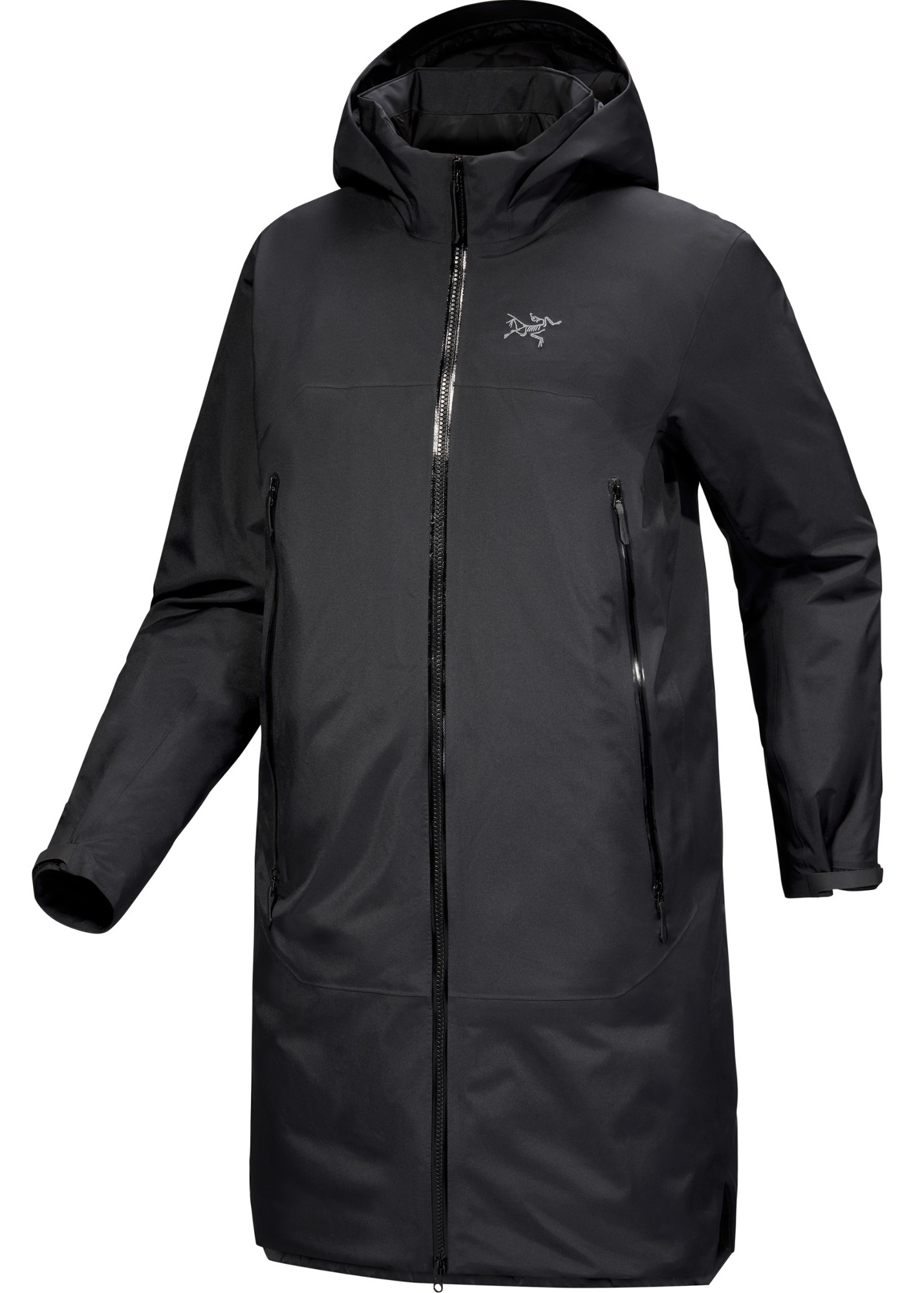 Fill: 850-fill down, 65g & 90g Coreloft Continuous synthetic
Fill: 850-fill down, 65g & 90g Coreloft Continuous synthetic
Center back length: 36 in.
Waterproof?: Yes
What we like: A waterproof and warm parka that’s at home both in the city and outdoors.
What we don’t: Very pricey and not quite as long as more casual parkas.
Many of the casual women's parkas on this list are in the sub-$400 price range, but nobody does jackets quite like Arc’teryx. The sleek Beta Down Parka is the whole package: You get 850-fill goose down with synthetic Coreloft insulation in areas most prone to getting wet, 3-layer Gore-Tex ePE waterproofing with their cozy C-Knit backer, and a classic design that can be worn pretty much anywhere. Features on this 36-inch-long jacket include a two-way front zipper, an internal waist adjuster, articulated patterning for improved mobility, and huge hand pockets, also with two-way zippers. Add in a nice variety of color options and the premium build quality that Arc’teryx is known for, and you have a fantastic winter parka that should stand up to cold and wet weather for many years to come.
The biggest hurdle in choosing the Beta Down (and why it ranks lower on our list) is price: At a whopping $900, it’s more than double the cost of jackets like the Patagonia Down With It and TNF Arctic above, which puts it out of reach for many. However, you do get some serious return on your investment: The full waterproofing is a nice feature, and few casual pieces use best-in-class Gore-Tex. You also get a tough-yet-smooth shell, which can handle everyday wear and tear much better than the thinner options above. Finally, we appreciate the non-puffy style of the Beta Down, which manages to be well insulated and highly weather-resistant while keeping a low-profile, almost rain jacket-like look.
See the Arc'teryx Beta Down Parka
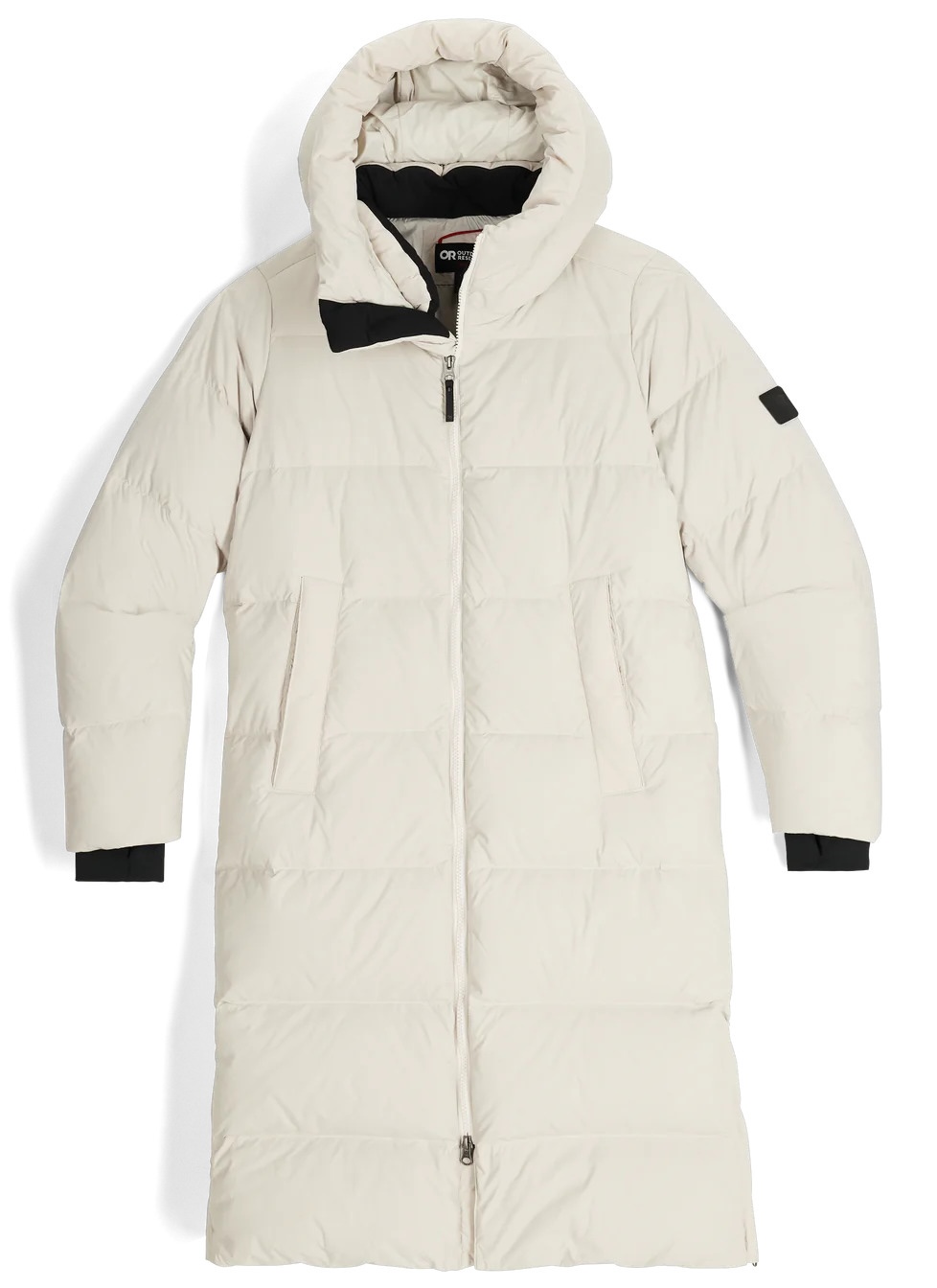 Fill: 8.3 oz. 700-fill-power down
Fill: 8.3 oz. 700-fill-power down
Center back length: 43 in.
Waterproof?: No
What we like: A true knee-length parka with a durable woven shell.
What we don’t: Expensive and sizing can be tricky.
We often turn to Outdoor Research for reasonably priced technical outerwear, but the Seattle-based company has gone fully casual with the Coze Down Parka here. And we like what they’ve done, combining high-quality materials with an elegant urban style. The knee-length Coze is by far the longest parka on this list, touting a 43-inch center back length that’s a full 9 to 10 inches longer than jackets like the Mountain Hardwear Stretchdown above and Marmot Montreal below. On top of that, you get a soft and durable 70D by 90D woven shell—great for withstanding the rigors of city use—and side zips that make it easy to sit, bike, or drive.
There are a lot of reasons you might want the extra coverage of the Coze, especially in particularly frigid winter climates. For one, the length eliminates the need for insulated pants on quick jaunts around the block. Second, you’re ensured insulation under you when sitting, which you don’t always get with a parka-length jacket. And finally, the style is undeniably classy, whether you’re walking the dog or going out on a Saturday night. Keep in mind that sizing can be tricky—we recommend finding a way to try on the Coze or purchasing from an online retailer with a good return policy—and unlike many parkas, you don’t get a cinch at the waist. But for top-notch coverage from a trusted brand, the Coze is an attractive option.
See the Outdoor Research Coze Down Parka
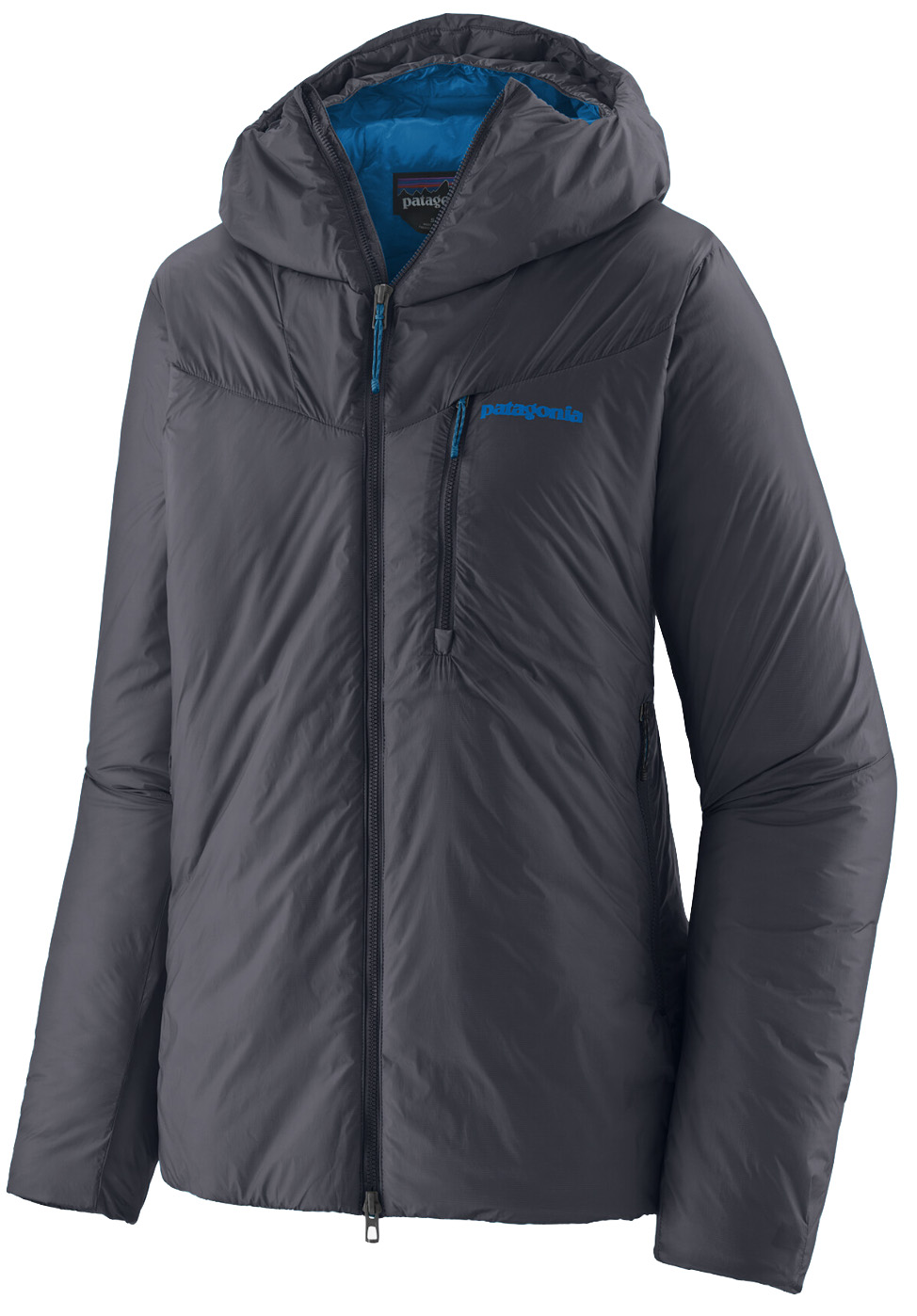 Fill: 133g & 40g PrimaLoft Gold Eco
Fill: 133g & 40g PrimaLoft Gold Eco
Center back length: 30 in.
Waterproof?: No
What we like: The wet-weather assurance of synthetic insulation.
What we don’t: Expensive and thin face fabric is very fragile.
The vast majority of jackets here use down fill, which is warmer (for the weight) and loftier than synthetic insulation. But there are undeniable benefits to synthetics: They continue to insulate when wet, breathe better, and provide a cruelty-free, vegan option for consumers (for more on the topic, see our article on down vs. synthetic insulation). One of our favorite cold-weather synthetic jackets, the Patagonia DAS Parka, is a high-performance piece that uses unique insulation mapping to pack in warmth while keeping weight on par with many technical down puffies (for reference, it's less than an ounce heavier than the Rab Neutrino Pro above). To top it off, the DAS is mountain-ready with a robust Pertex Quantum Pro shell, a helmet-compatible hood, and a two-way front zipper with a protective wind flap.
In terms of downsides, the DAS Parka is a decidedly technical piece with a roomy, layering-friendly fit and a noticeably thin (10D), no-frills shell. And while there’s no denying that the warmth is impressive for the weight, especially for a synthetic jacket, cost remains high at $449 (synthetics generally save you some money, but not in this case). In short, the DAS has limited daily appeal, but for the right environment—think drippy alpine belays or digging snow pits while backcountry skiing—it’s a nice choice. And for drier conditions or when space is at a premium, Patagonia's down-filled Fitz Roy ($399) offers roughly the same amount of warmth at only 14.8 ounces.
Read more: Patagonia DAS Parka review
See the Patagonia DAS Parka
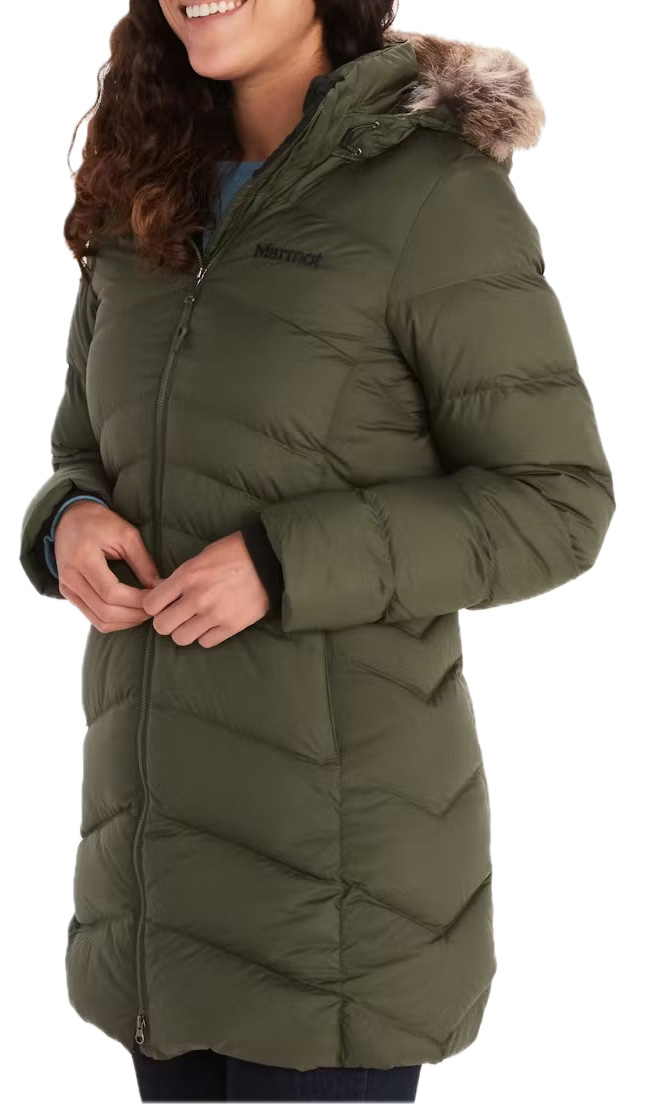 Fill: 700-fill-power down
Fill: 700-fill-power down
Center back length: 34 in.
Waterproof?: No
What we like: Attractive styling and great mobility and comfort.
What we don’t: Warmth falls short of many of the longer down parkas above.
Winter jackets come in a range of styles and vary considerably in terms of warmth, but the Marmot Montreal Coat strikes a nice middle ground for most winter environments. Reasonably priced at $300, you get a healthy dose of 700-fill-power down and a mid-thigh cut that keeps you covered without limiting mobility. Unlike most puffy jackets here, the Marmot is lined with a soft and supple fleece along the torso, cuffs, and hand pockets, and a removable faux-fur liner around the hood keeps cold air out and tacks on an extra dose of style. Add in a DWR finish, and the Montreal is a nice everyday defense against the cold and occasional precipitation.
We love the cut of the Marmot, which hovers about mid-thigh and offers a more mobile and playful feel than longer jackets like the Down With It above (34 vs. 39.3-in. center back length). This style is great for activities like riding a bike and shoveling the driveway, but you do give up a significant amount of coverage and warmth. Further, the parka’s overall build quality is a bit less impressive than the aforementioned Patagonia, with a thinner shell that won’t hold up as well over time. All gripes aside, we’ve found the Montreal to be sufficient for temperatures above 20 degrees Fahrenheit, which is a good match for the majority of winter conditions in most of the U.S. And like many casual parkas, it does have a trim fit, so consider sizing up if you plan to layer underneath.
Read more: Marmot Montreal Coat review (prior version)
See the Marmot Montreal Coat
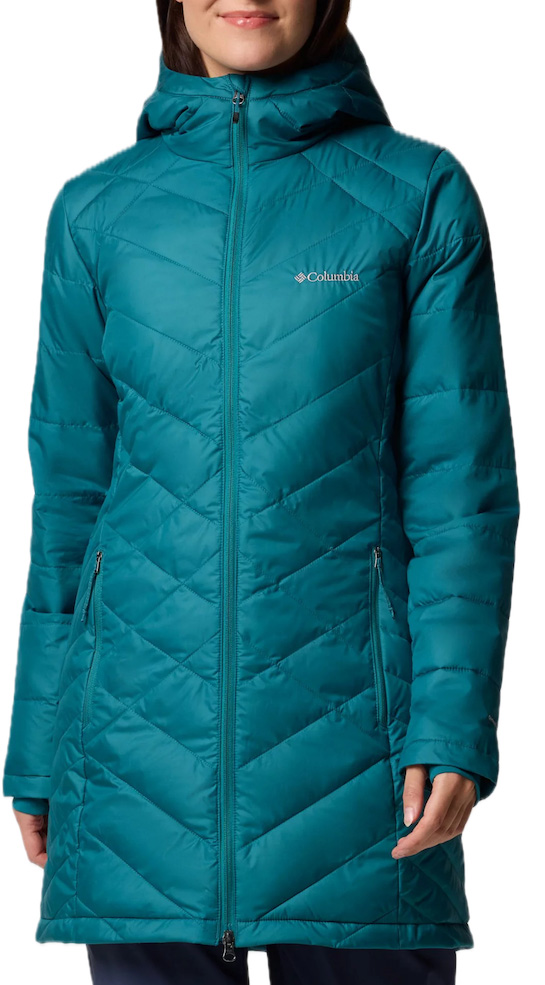 Fill: Synthetic
Fill: Synthetic
Center back length: 34 in.
Waterproof?: No
What we like: A great value and clean overall design.
What we don’t: Not as warm or soft as a down jacket.
Winter jackets are an expensive bunch, but budget-oriented brand Columbia offers some intriguing alternatives that save you a good deal of cash. Our favorite is the Heavenly Long Hooded Jacket, which checks many of the boxes we look for in a cold-weather piece while coming in at a very reasonable $160 price point. For warmth, you get a healthy amount of Columbia's in-house polyester fill (although a fill weight isn't provided), along with a shiny Omni-Heat reflective lining, water-resistant shell, comfortable hood, and surprisingly good fit and design for the price. Despite the name, the Heavenly certainly isn’t as pillowy-soft as down, but it’s a good-looking jacket and one heckuva value.
What are the downsides of a jacket like the Columbia Heavenly? It won’t pack away into a suitcase nearly as small as a comparable down jacket (synthetic insulation is much less compressible), and you don’t get the same warmth for the weight, either. The jacket does get reasonably high marks for being cozy in cold conditions, but you likely will want to layer up when the temperatures get truly frigid. These issues aside, the jacket looks the part for both outdoor and urban use, comes in a variety of classy colorways, and won't break the bank, making it popular year after year.
See the Columbia Heavenly Long Hooded Jacket
| Jacket | Price | Insulation | Length | Weight | Waterproof? |
|---|---|---|---|---|---|
| Patagonia Down With It Parka | $349 | 8.5 oz. of 600-fill | 39.3 in. | 2 lb. 5.0 oz. | No |
| REI Norseland Down Parka | $229 | 650-fill down & synthetic | 36.5 in. | 2 lb. 2.2 oz. | No |
| Patagonia Tres 3-in-1 Parka | $699 | 5.6 oz. of 700-fill | 35.5 in. | 3 lb. 3.0 oz. | Yes |
| Rab Neutrino Pro | $400 | 7.5 oz. of 800-fill | 28.3 in. | 1 lb. 1.7 oz. | No |
| Canada Goose Expedition Parka | $1,675 | 625-fill down | 32 in. | 4 lb. 7 oz. | No |
| Paka Apu Parka | $349 | 130g & 110g Pakafill | 28 in. | 1 lb. 10.1 oz. | Yes |
| The North Face Arctic Parka | $350 | 600-fill down | 35.3 in. | 2 lb. 10 oz. | Yes |
| REI Co-op Stormhenge 850 Down | $279 | 850-fill & synthetic | 28.3 in. | 1 lb. 6.9 oz. | Yes |
| Rab Deep Cover Parka | $315 | 12 oz. of 700-fill | 35.4 in. | 1 lb. 13.1 oz. | No |
| Outdoor Research Coldfront | $279 | 5.6 oz. of 700-fill & synthetic | 29.5 in. | 1 lb. 5.2 oz. | No |
| Fjallraven Nuuk Parka | $500 | Synthetic (250g) | 33.9 in. | 3 lb. 13.1 oz. | Yes |
| Kühl Crossfire Parka | $369 | 10.1 oz. of 650-fill & synthetic | 40 in. | 1 lb. 8.0 oz. | No |
| MH Stretchdown Parka | $350 | 700-fill down | 33 in. | 1 lb. 8.6 oz. | No |
| Arc’teryx Thorium Hoody | $500 | 5 oz. of 750-fill & synthetic | 26.8 in. | 1 lb. 0 oz. | No |
| Patagonia Jackson Glacier Parka | $499 | 8.2 oz. of 700-fill | 37.3 in. | 2 lb. 5.6 oz. | Yes |
| Arc'teryx Beta Down Parka | $900 | 850-fill & synthetic (65 & 90g) | 36 in. | 1 lb. 11.2 oz. | Yes |
| Outdoor Research Coze Parka | $399 | 8.3 oz. of 700-fill | 43 in. | 2 lb. 3.5 oz. | No |
| Patagonia DAS Parka | $449 | Synthetic (133g & 40g) | 30 in. | 1 lb. 2.4 oz. | No |
| Marmot Montreal Coat | $300 | 700-fill down | 34 in. | 2 lb. 0 oz. | No |
| Columbia Heavenly Long | $160 | Synthetic | 34 in. | 1 lb. 10 oz. | No |
For most of the staff at Switchback Travel, winter involves spending a lot of time outside in the cold—on skis, snowshoes, a snowboard, or with winter traction devices attached to our boots. To help stay warm and cozy, a quality winter jacket is a staple in our winter wardrobes. To supplement our unisex winter jacket round-up, which covers both men's and women's styles, former senior editor Jenny Abegg put together our initial list of 20 women's-specific picks in 2021, drawing from years of experience braving cold and wet weather throughout the Pacific Northwest. Editor-in-chief Penney Garrett took over the guide in 2024 from her home base in Lake Tahoe, where unpredictable weather and long winters are par for the course. Testing is rounded out by other women on the Switchback team, all of whom are backcountry enthusiasts who know the importance of staying cozy and protected in driving winds, sustained precipitation, and plummeting temperatures.
In landing on our current selection of 20 women's winter jackets above, we took several factors into account. Warmth is an obvious consideration for most, but climate will play a big role in how much insulation you need, so we made sure to include a range of designs—from affordable synthetics to premium down-filled pieces and cutting-edge hybrid designs. Since cost will be a deciding factor for many, we prioritize designs that strike a good balance between price and performance. Other characteristics we evaluate include length, fit, weight, and packability, although these are largely dependent on your personal preferences and objectives. Whether you're looking for a casual everyday parka or a heavyweight down jacket for backcountry adventures, we've got you covered with our comprehensive lineup, which we update regularly to keep options fresh and relevant.

When deciding on a winter jacket, the single most important factor will be its intended use. Casual winter jackets are designed for everyday wear around town and are characterized by their urban styling, excellent coverage, and typically heavy builds. Thigh- and knee-length parkas like the Patagonia Down With It Parka fall into this category and are very popular among women for their warmth and classy looks. Performance jackets, on the other hand, are more technical in nature, built to handle cold, wet mountain weather, and are often made with higher-loft down and lighter shell materials. These lightweight models are designed for activities like mountaineering, climbing, and other cold-weather backcountry use.
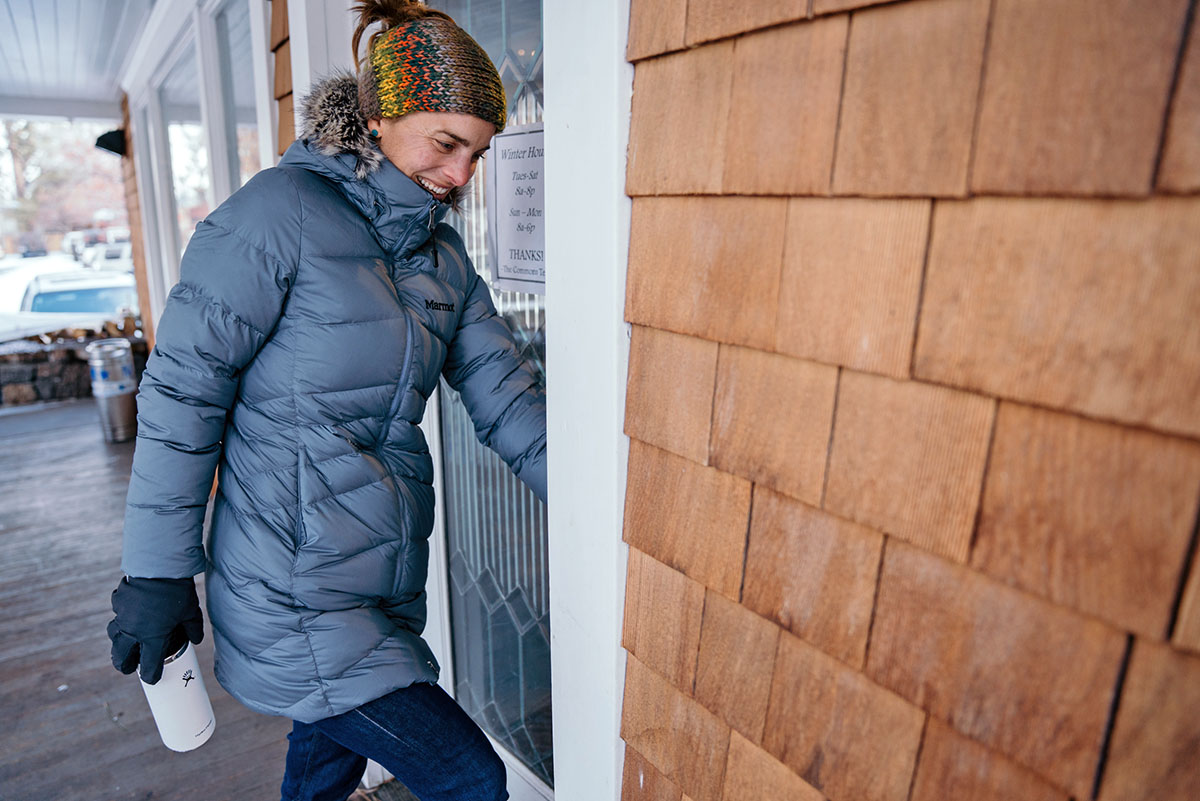
The good news is that going with a casual coat generally saves you a good deal of money. Two of our top casual picks, The North Face Arctic Parka and the Patagonia Down With It Parka, are around $350 yet offer ample warmth and weather protection. The compromises come in weight, packability, and range of movement, which matter if you’re climbing mountains but not so much for the morning commute. And for casual users drawn to the look of jackets in the performance category, keep in mind that these are generally less durable and won’t hold up as well to everyday wear (with exceptions being burlier designs like the Arc'teryx Beta Down Parka). We include a smattering of performance options here, but for a more in-depth look, check out our articles on the best women's down jackets and best women's synthetic insulated jackets.

Most jackets on this list have down fill, which is known for its warmth, light weight, and compressibility. A few jackets, including the Columbia Heavenly Long, are made exclusively with synthetic insulation, which is heavier and not quite as lofty but does a superior job at insulating when wet. Synthetics are also cheaper than down, which is why you'll find them inside budget-oriented designs, though each year, we see more and more down/synthetic hybrids that include synthetic insulation in high-exposure areas for added weather protection or under the arms for breathability. And the market continues to innovate: This past year, we tested the Paka Apu Parka, which uses a completely new type of insulation called Pakafill that's made with traceable alpaca fiber from Peru. Pakafill is stated to have half the volume of down while being water-resistant like a synthetic. We were impressed with the warmth and light weight of the stylish Apu Parka and are excited to see a new sustainable insulation that doesn't require fossil fuels or harm animals.
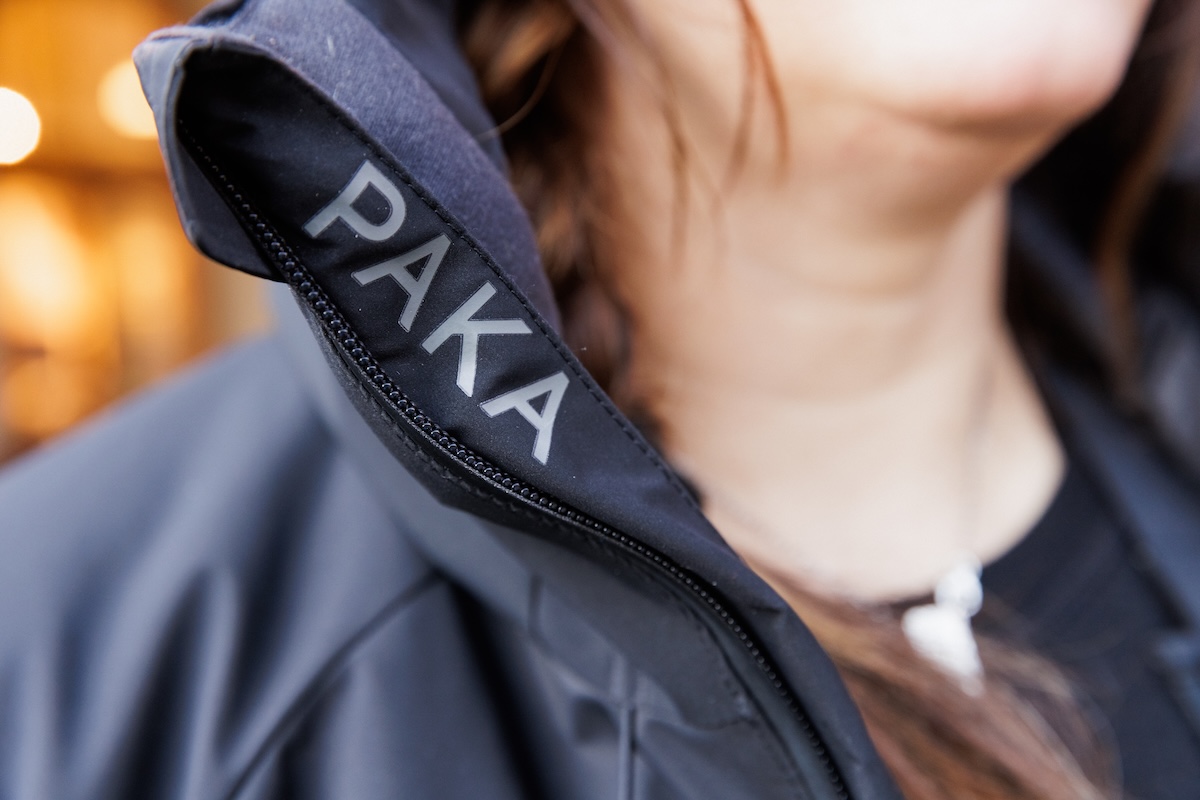
On that note, the ethical debate of down vs. synthetic insulation is an important one, but not as cut-and-dry as some might wish. Down is easy to scrutinize, with concerns around sourcing feathers and humane treatment of animals. On the other hand, most synthetic fills are petroleum-based, which results in greenhouse gas emissions and potentially unsafe work environments. Further, they can release micro pieces of plastic into the water during each wash. Programs like the Responsible Down Standard ensure the use of ethically sourced down, which makes it a much easier sell for us. On top of that, down generally has a longer lifespan than synthetic insulation. As mentioned above, we're excited to see a new player from Paka in the form of Pakafill. Paka claims this sustainable alpaca fiber tested warmer than synthetics yet is compressible and can stay warm while wet (unlike down). Paka won an ISPO award for their Apu Parka, so it's pretty clear they're onto something.
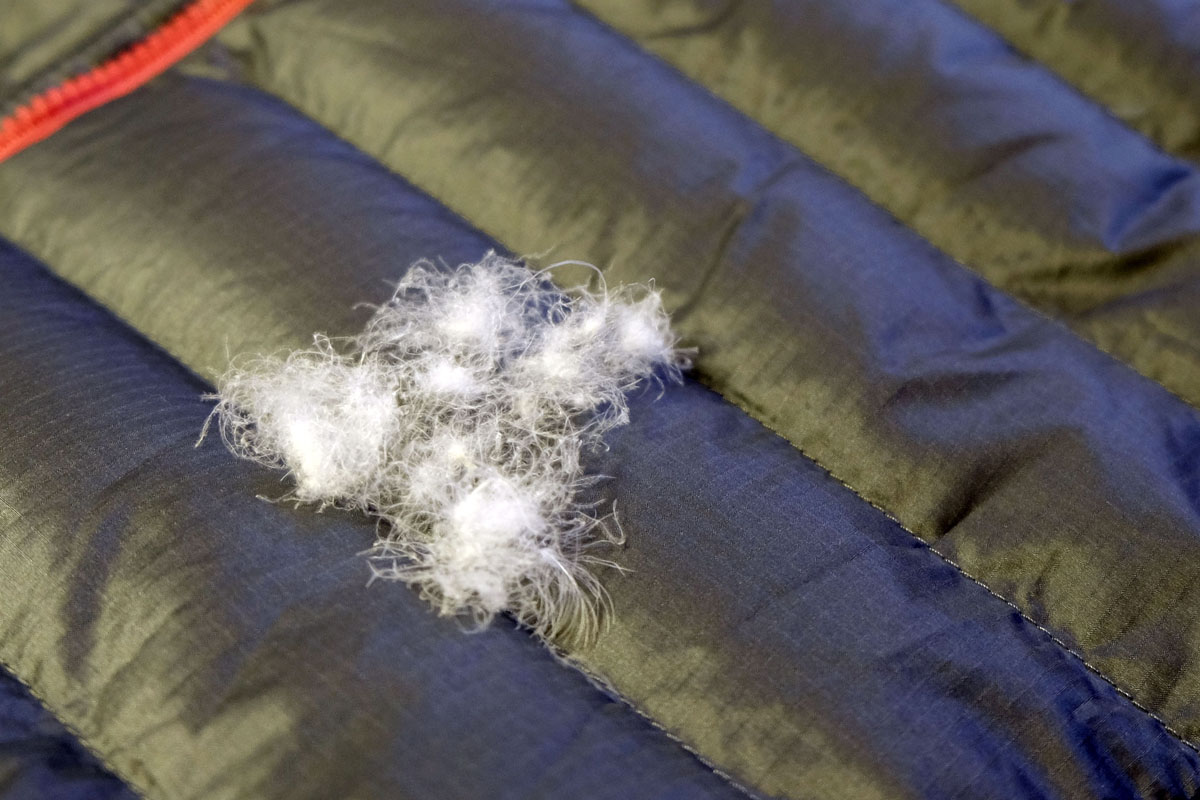
Warmth is a function of many variables: insulation type and weight, shell fabrics, wind, layering, level of exertion, and how warm or cold you run personally. But all other factors being equal, the two most important specs to look at when determining the warmth of your jacket are fill power and fill weight.
Fill Power
Fill power is the most heavily marketed spec among winter jackets and parkas, and it refers to down specifically. The higher the number (600-fill, 700-fill, 800-fill, etc.), the more loft and warmth the down will provide and the better it will compress when packing the jacket away. Premium down is the most expensive, which is why you’ll see this number loosely correlate with price. Performance winter jackets usually are around 800-fill or higher, and casual pieces run from 600-fill to 750-fill.
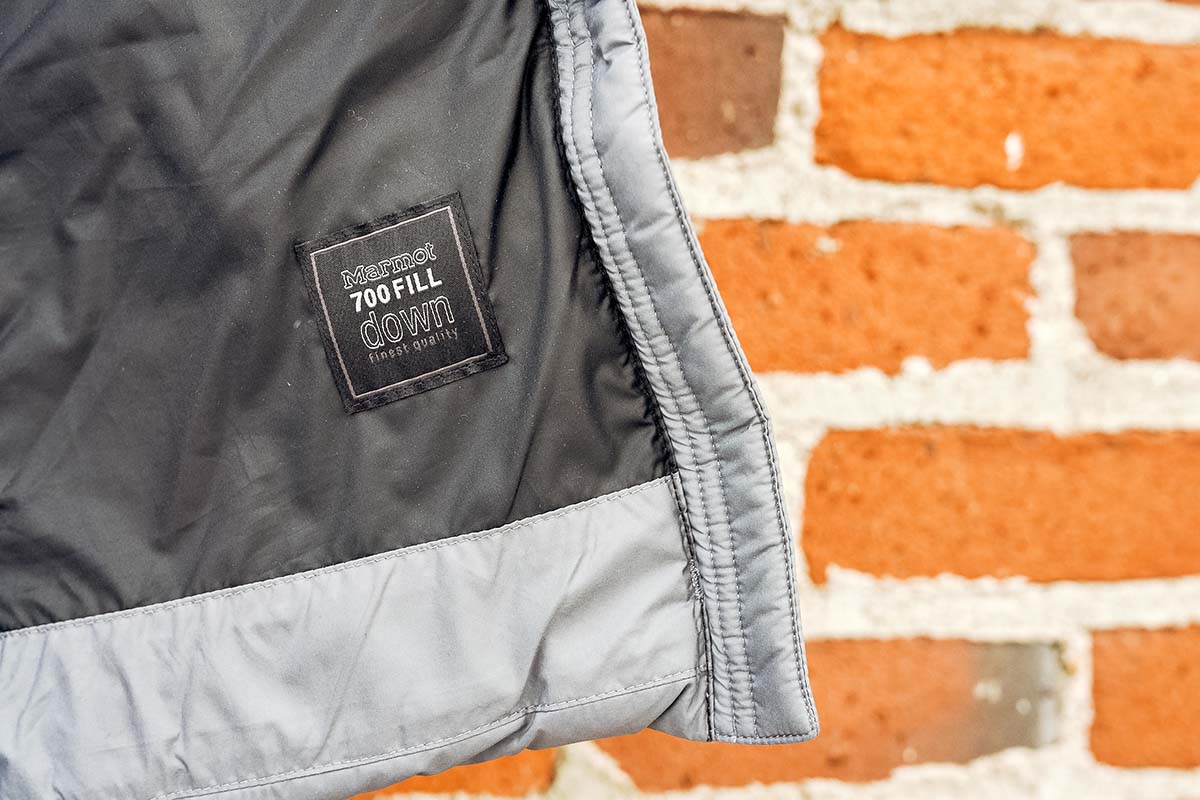
Fill Weight
Fill weight is often overlooked but just as relevant as fill power. Instead of measuring the quality of the down, fill weight indicates the total weight of the down inside the jacket. For example, the Rab Deep Cover Parka has a whopping 12 ounces of 700-fill-power down, while the Patagonia Jackson Glacier Parka has 8.2 ounces of 700-fill down, which represents a sizable difference in warmth. The calculation becomes more difficult the greater the gap in fill powers: Comparing 850-fill down to 500-fill down is like comparing apples to oranges, so it’s most helpful when the fill powers are at least similar. Unfortunately, fill weight isn’t always provided by manufacturers, particularly for casual pieces. We do everything within our power to acquire that number—including spending time on hold and explaining to customer service reps that fill weight is different than fill power—and include it in our comparison table when available.

Winter jackets don’t have a uniform method of measuring warmth like the EN system for sleeping bags, but there are some good clues. As discussed above, make sure to take both fill power and fill weight into account. In addition, the shell of the jacket matters, as do the layers underneath. By our best estimation and personal testing, the majority of the jackets on our list are designed to go well below freezing for use during the winter months in cold climates. Some jackets are capable of even more extreme conditions (the Canada Goose Expedition Parka is given a -22-degree Fahrenheit rating by the manufacturer), while others are less insulated and designed for milder conditions. Remember to layer well and don’t take any chances, but this article presents that warmest jackets that we've tested. For more lightweight and midweight jacket options, see our articles on the best women's down jackets and best women's synthetic insulated jackets.
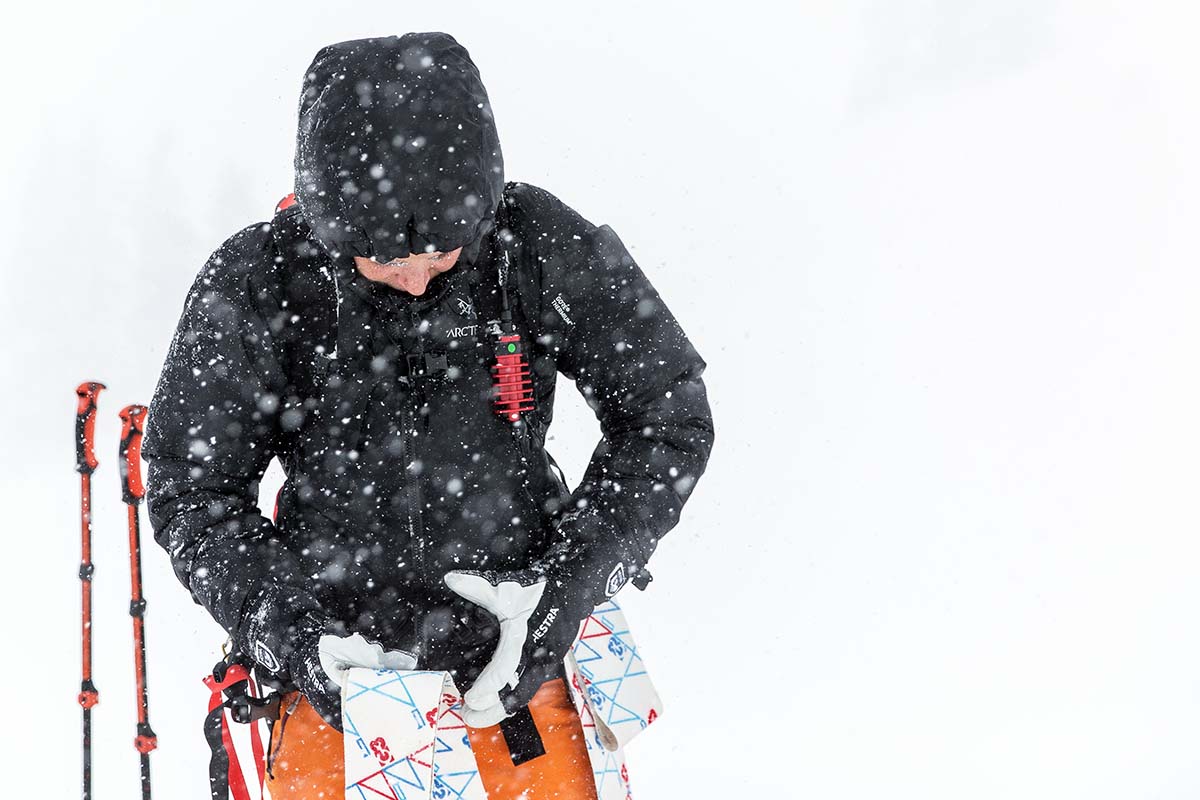
The jackets on our list above come in a variety of lengths, ranging from 26.8 inches for the Arc'teryx Thorium Hoody to 43 inches for the Outdoor Research Coze Down Parka. In the majority of cases, this measurement is taken down the center of the back, where a jacket is at its longest (some hems are uniform all the way around, while others feature a drop-tail). Hip-length jackets check in anywhere from 26 to about 30 inches, below-the-butt parkas are around 33 inches, and mid-thigh to knee-length parkas range from about 35 to 43 inches in length. The center back length can be an important consideration when you're shopping for a jacket, as it has a big impact on style, warmth, and coverage. Keep in mind that if you opt for a longer jacket, you'll want to look for features like slits (these can be in the front, back, or at the sides) and two-way zippers, which help with range of motion.
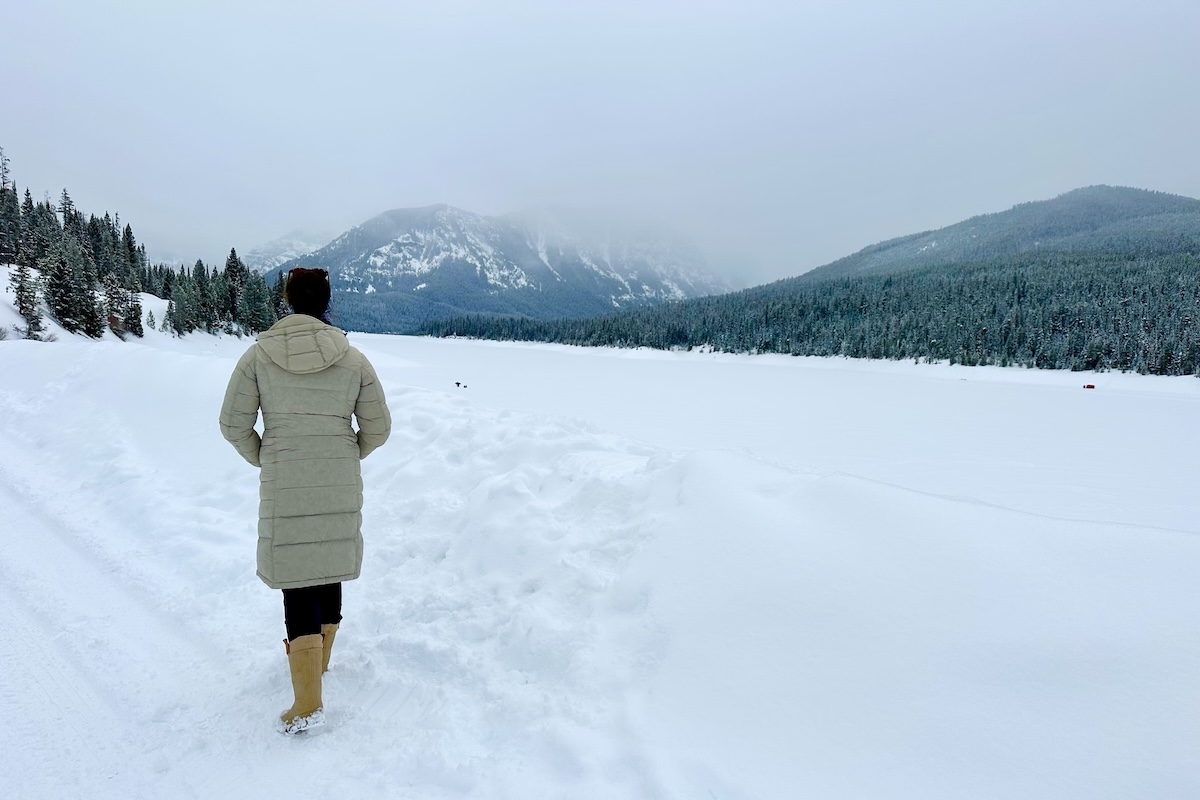
Winter jacket styling can be all over the place. Some, like the Marmot Montreal, are fairly trim, while others, particularly performance jackets like the Rab Neutrino Pro, provide ample space for freedom of movement and layering. It’s a strong generalization, but expect casual pieces to run a bit small (we’ve often found the need to size up) and performance pieces to be roomier. When applicable, we’ve called out sizing discrepancies in the write-ups above, but there’s no substitute for going into your local gear shop and trying on jackets in person to get to know how various brands approach their sizing.
Parkas come in a variety of lengths ranging from just below the butt (as seen with the Mountain Hardwear Stretchdown and Marmot Montreal) to knee-length designs like the Outdoor Research Coze. While parkas are the clear winners in terms of warmth and coverage (and arguably style), it’s important to understand where these designs fall short. In general, the longer the hem, the more restrictive a parka will be—we’ve had to pull up jackets around our waist while biking—and many of these designs have a tendency to bunch up on your lap while sitting or driving. We’ve found that slits like those on the REI Co-op Norseland Down Parka (side) or Kühl Crossfire Parka (front) go a long way in solving this problem, and you'll want to be sure the design features a two-way zipper.
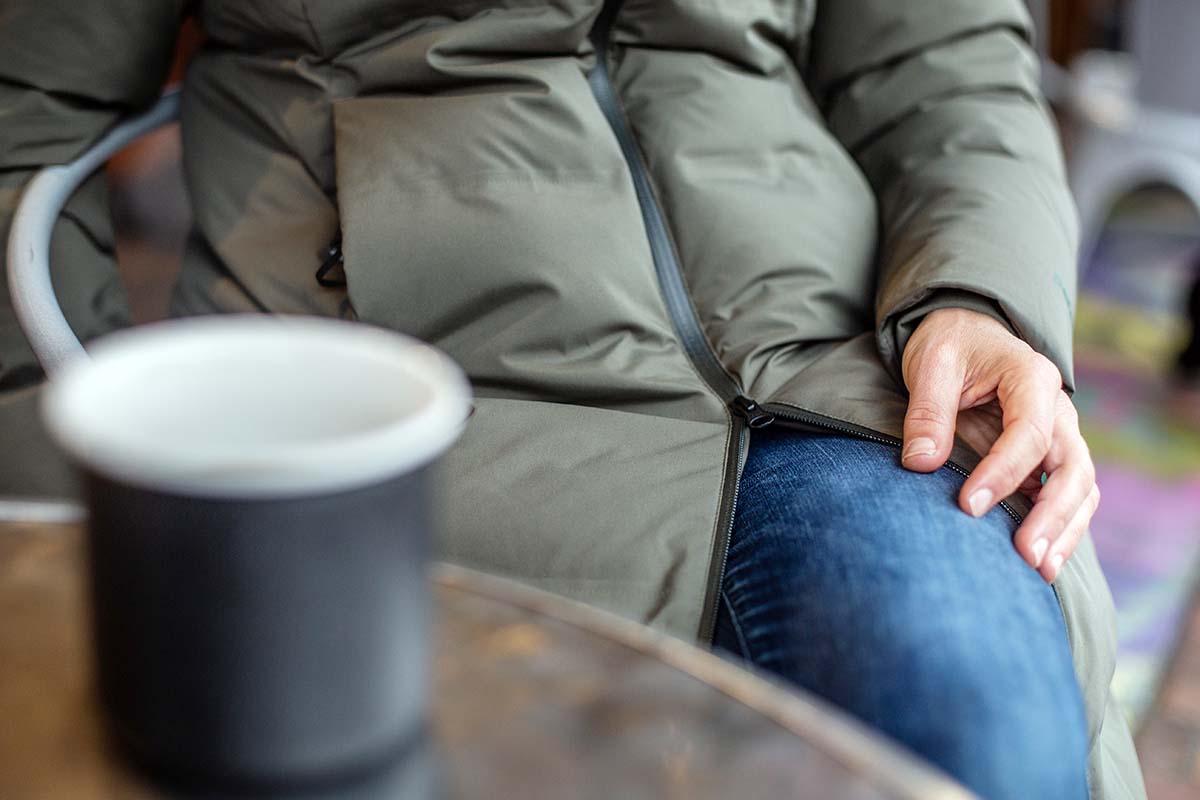
A major contributor to warmth is what layers (or lack thereof) you wear underneath your jacket. Due to the hefty amount of insulation inside most of the jackets above, a simple baselayer will do the trick in moderately cold weather. When the temperature drops to well below freezing you may want to add a lightweight down or synthetic jacket as a midlayer. This would be a lot of insulation and it depends on the parka, but it’s an easy adjustment to make so long as the jacket has room for layering. Warmth is a lot about personal preference and the specifics of the activity and conditions, but it’s always a good idea to carry an extra layer or two should you get cold or the conditions change.
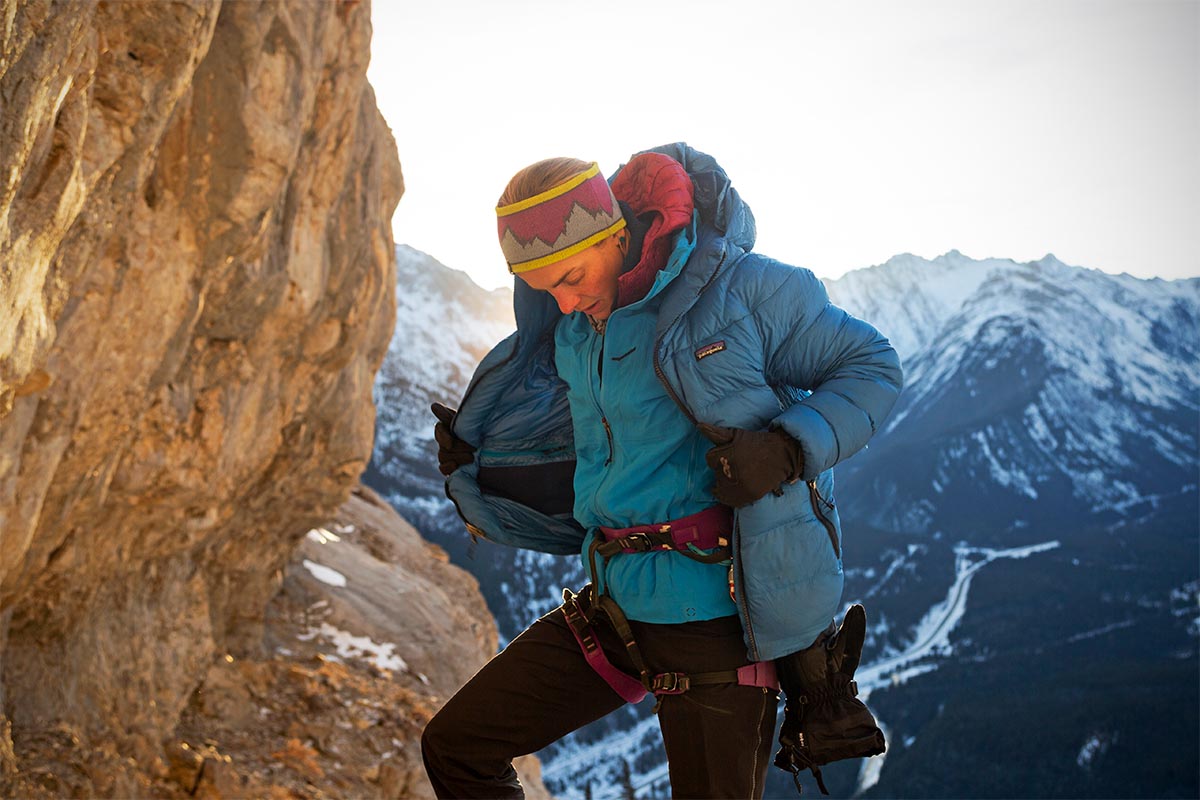
The importance of weight in your buying decision depends largely on intended use. For those looking in the performance category (mountaineers, climbers, winter explorers, etc.), jackets with large amounts of premium down will be the warmest, lightest, and most packable. Our top pick in this category is the Rab Neutrino Pro, which checks in at 1 pound 1.7 ounces, though we also really love the well-featured, 1-pound-10.1-ounce Paka Apu Parka. For those buying at the casual end of the market, weight matters much less—you most likely won’t be carrying your down jacket in a backpack and don’t care as much about shaving ounces. Many casual winter jackets and parkas push the 3-pound mark (or more) and won’t pack down as small with lower-fill-power down.
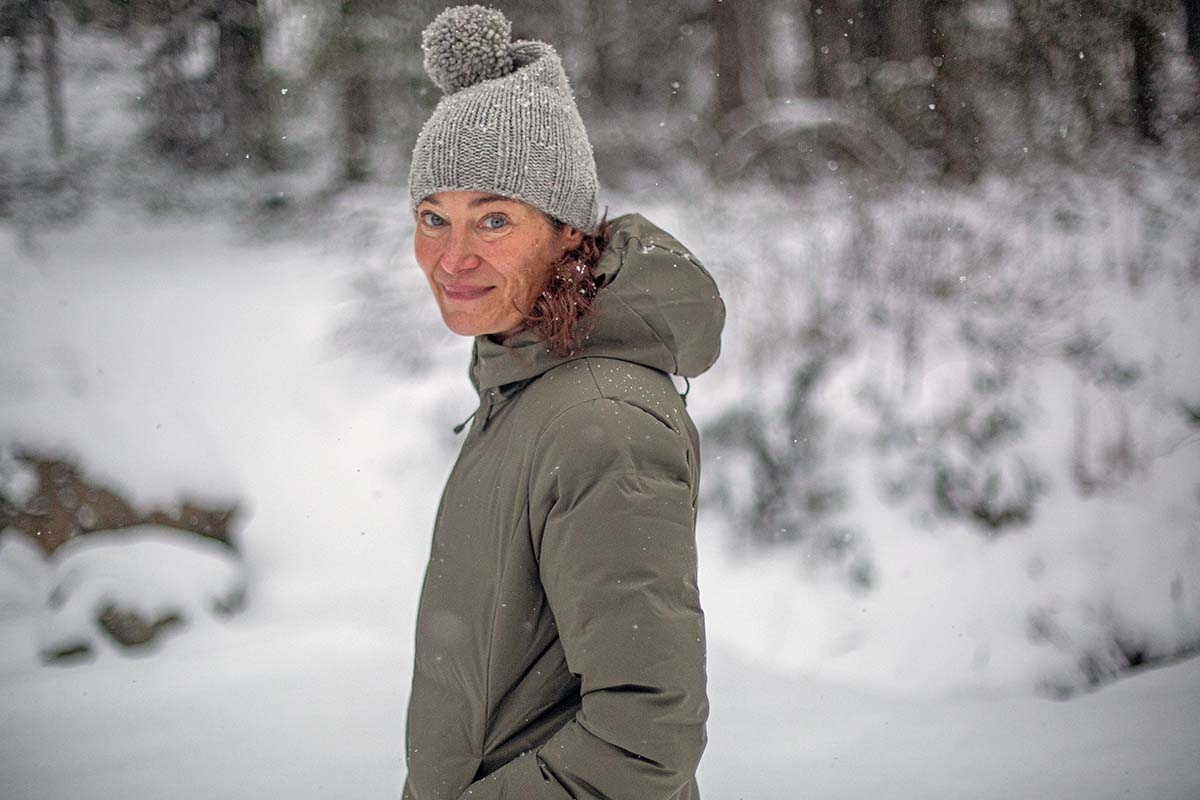
A jacket’s weight and packability often go hand in hand, so taking a look at the weight spec should give you a fairly accurate idea of how compressible each jacket is. Like weight, packability is paramount for performance use but won’t matter too much for most casual users—although it does have implications for stuffing in a duffel when traveling. A packable jacket (like the Patagonia Fitz Roy Down Hoody and DAS Parka) will be much easier to stuff away in a checked bag or overhead bin, whereas the hefty Canada Goose Expedition Parka will fill up an entire carry-on suitcase. If packability matters, we recommend opting for a hip-length jacket or a simple down parka with thin shell fabric like the Marmot Montreal. And as we mentioned, down is much more packable than synthetic insulation.
In addition to the type and amount of insulation, a jacket’s shell fabric has a big influence on its weight and packability. Performance jackets tend to use technical fabrics that are light and thin, while casual pieces use more durable and heavier shells that add weight. On the upside, the thicker shells are much better at avoiding tears and small abrasions and therefore should last longer. Lightweight down jackets require quite a bit of care and attention and are not our first choice for everyday use (unless you don’t mind the odd patch here and there).
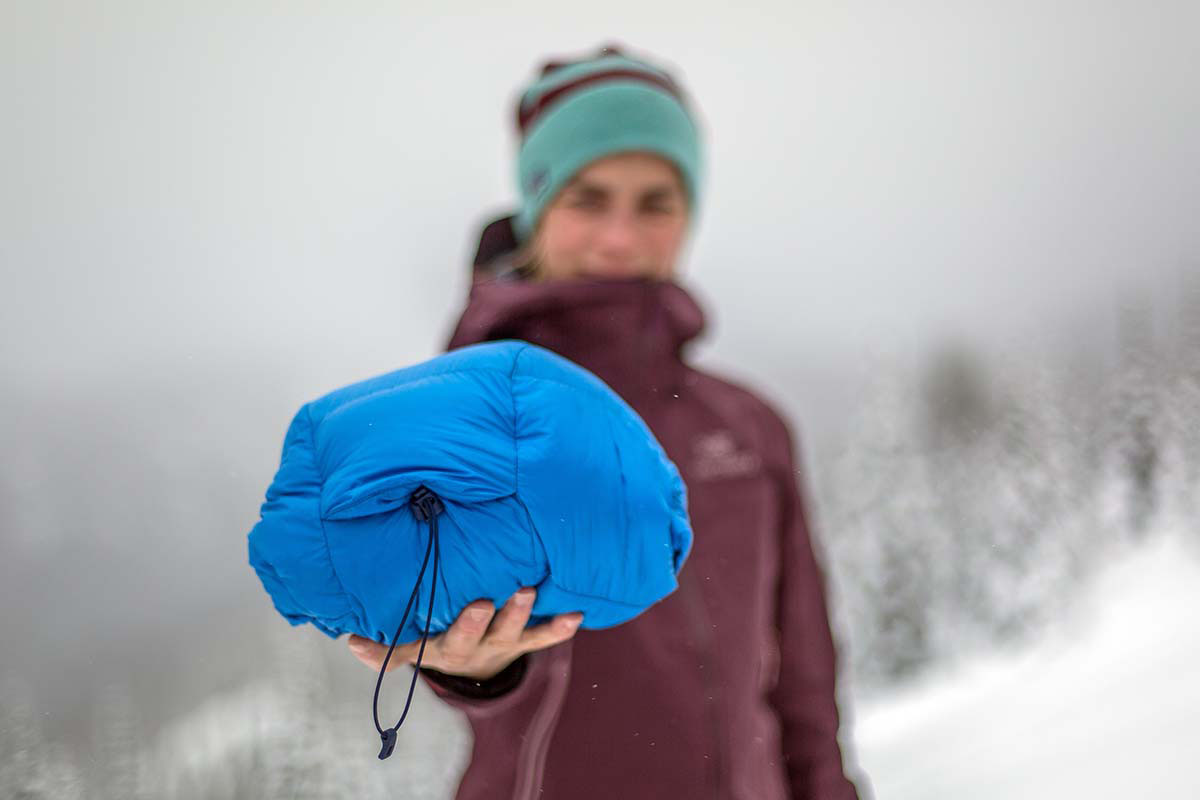
Down loses its ability to insulate when wet, and therefore all jacket materials on this list offer some protection against precipitation. Most of the shells are water-resistant or water-repellant, meaning they have a tightly woven face fabric and durable water-repellant (DWR) coating that will bead up and shed light moisture. If you combine that with treated or hydrophobic down—a treatment added to the down itself that reduces water absorption and helps it dry faster—you have a pretty effective system even in wet and heavy snow.
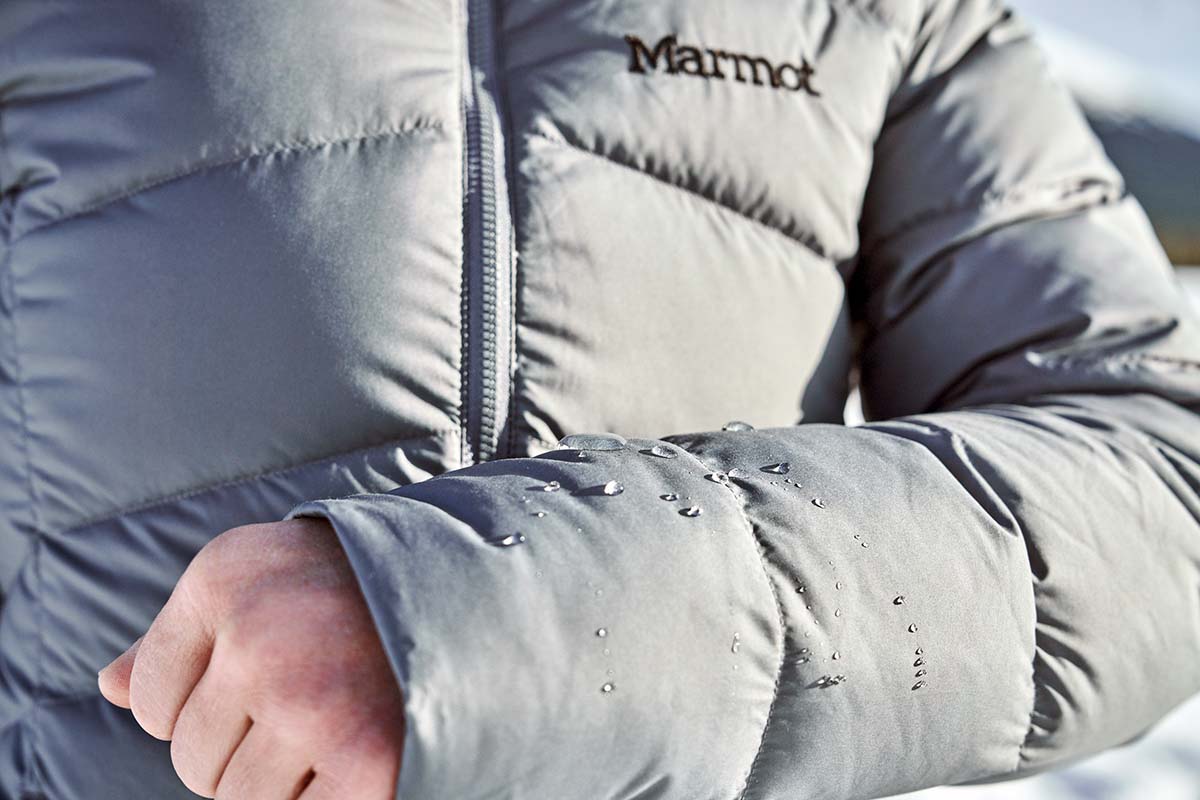
Jackets with water-resistant shells like the Marmot Montreal offer plenty of protection in freezing, snowy conditions. If you do need complete waterproofing, however, there are plenty of options on the market, including The North Face Arctic, REI Stormhenge, Fjallraven Nuuk, and multiple offerings from Arc'teryx and Patagonia. The Arc'teryx Beta Down Parka has a 3-layer waterproof Gore-Tex ePE shell for staying dry if it happens to be 34 degrees and pouring rain.
Exposure to wind can make an otherwise freezing winter day even more unbearable. In terms of the wind resistance of a winter jacket, a number of factors come into play including the type and thickness of the shell, amount and distribution of the insulation, and liner fabric. The shell itself matters most: On performance jackets, you’ll see names like Gore Infinium or Pertex for excellent wind resistance at low weights, and casual coats often block the wind by the sheer thickness of the face fabric. In the end, all of these jackets do a respectable job at keeping wind and the other elements at bay. Midweight and lightweight jackets are much less substantial, and you run the risk of catching a cold breeze through the jacket itself, but this list is composed of heavyweights that all should be considered highly wind-resistant.
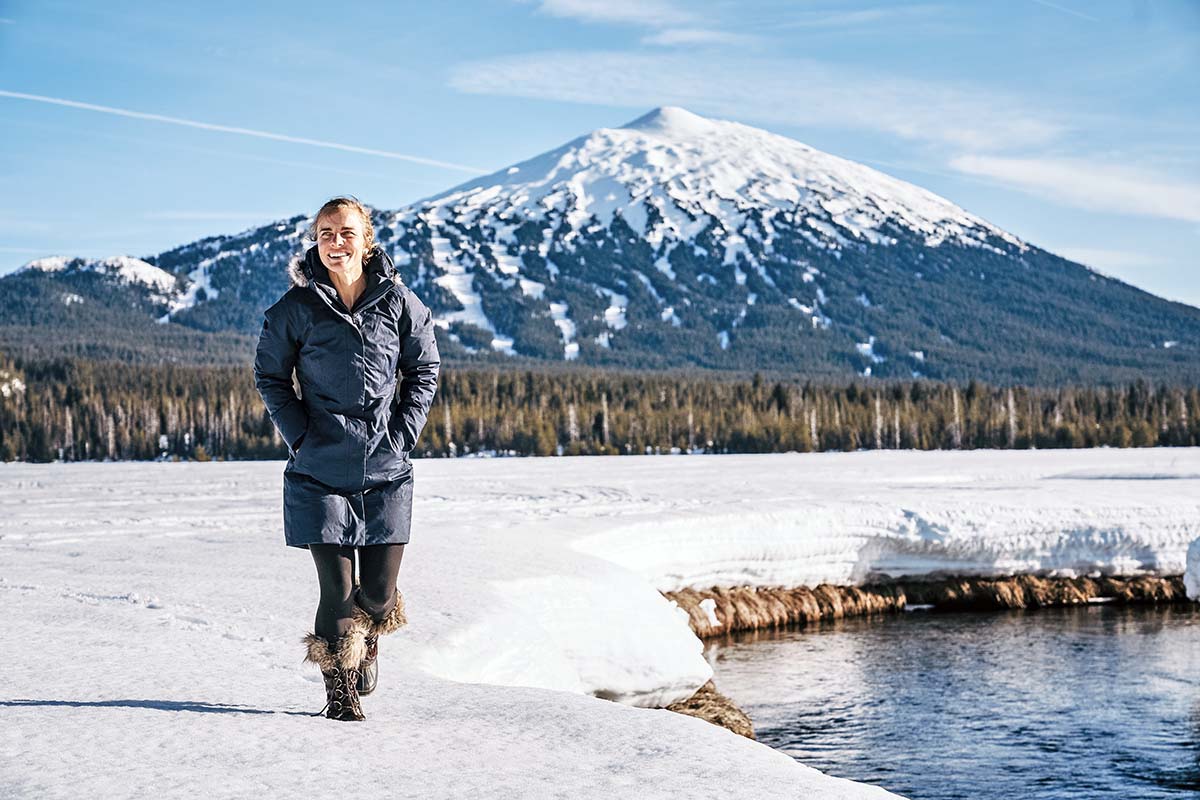
Perhaps more than any other type of jacket, the hood matters a lot with a winter coat. First, the hood will almost always have the same type of insulation as the rest of the jacket, so premium down in the body of the coat means excellent warmth for the weight in the hood. Second, a good cold-weather hood can be adjusted and tightened around the head so that wind doesn’t enter or blow it off your head (many casual jackets will have an additional fur brim—often removable—for sealing in warmth, while technical models often have storm flaps around the collar). Finally, many performance-oriented jackets have helmet-compatible hoods, which are necessary for mountaineering and climbing. Helmet compatibility makes the hood larger and slightly less desirable for wearing without a helmet, but it isn’t a dealbreaker as long as the hood cinches down evenly.
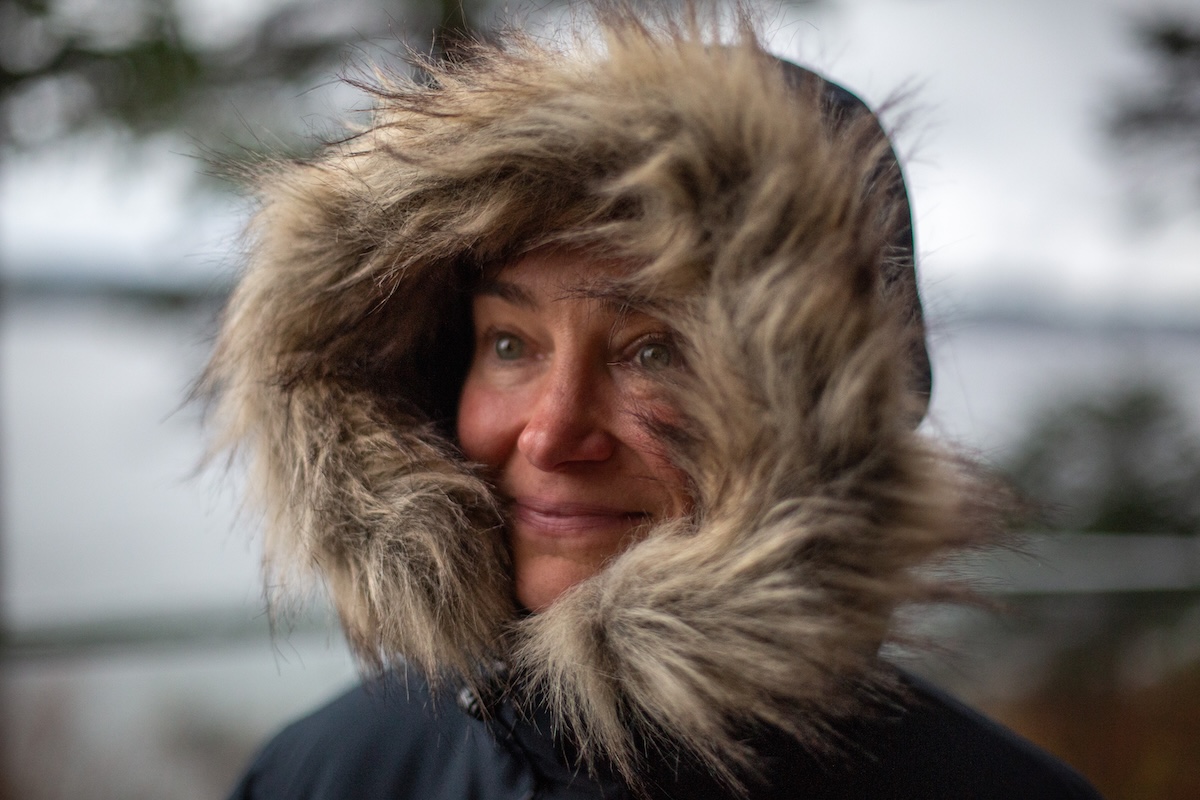
For use on mild-weather days, some prefer the option to remove the hood from their winter coat altogether. These hoods are bulky and can be annoying if they’re just sitting along the back of your head. Most designs have a zipper located just below the collar to make it easy to remove and put back on. The feature does add weight and bulk, so you’ll typically find it on casual winter jackets (like the Fjallraven Nuuk Parka). Whether this is a priority will come down to personal preference, but it could be a difference-maker in the jacket you select.
The outdoor apparel world has seen a sizable uptick in the use of sustainable practices over the past several years, and winter jackets are no exception. Key measures include recycled materials, ethically sourced down (or alpaca, as seen from the company Paka), and PFAS-free DWR coatings (traditional coatings use per- or polyfluorinated chemicals—"forever chemicals" known to be harmful to the environment). With many states stepping up to ban the sale of items that include PFAS, the outdoor industry is seeking better solutions for water- and stain-resistant finishes (you can read more about Patagonia’s take on the issue here). Bluesign approval has also become one of the gold standards in this realm, indicating that materials have been sourced and produced in ways that mitigate harmful impact on the environment. Finally, many companies are now Fair Trade Certified, which ensures the fair and ethical treatment of workers.
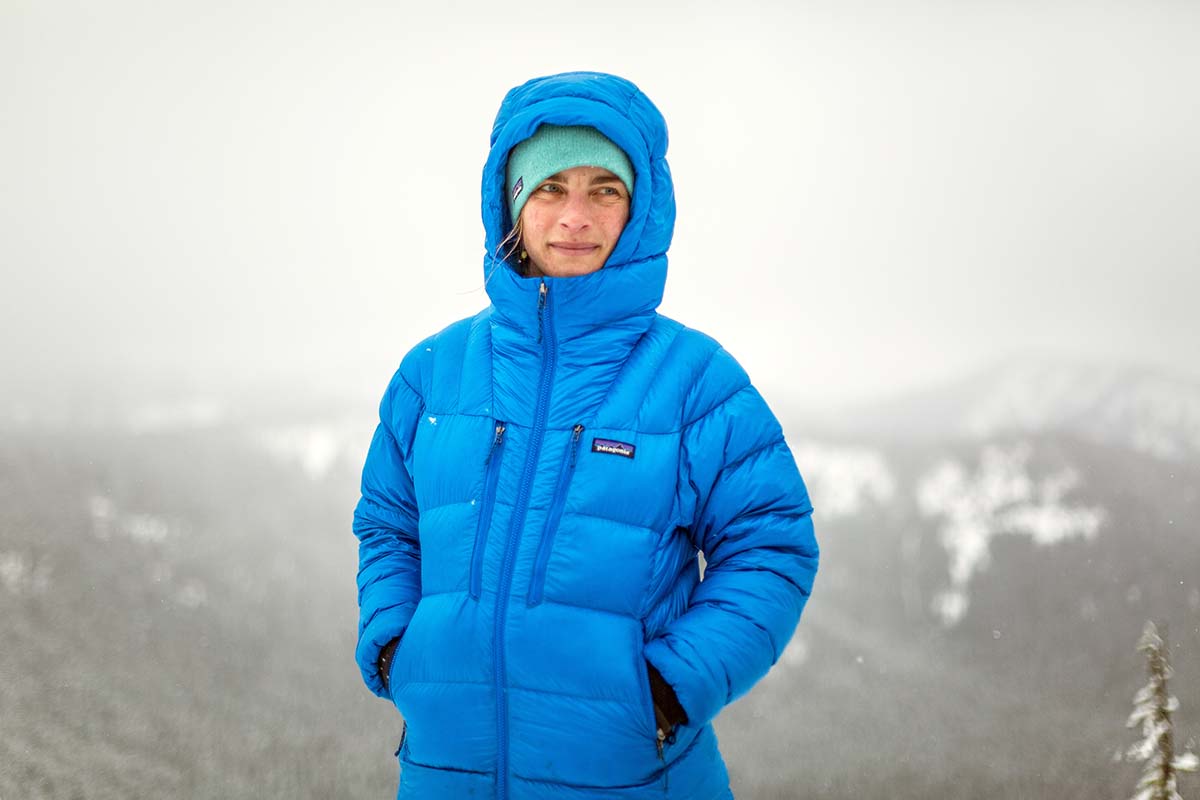
The good news is that most brands call out these practices, making it easy to shop with an eye for sustainability. Patagonia is a clear leader: Their Down With It Parka, for example, uses a 100%-recycled face fabric with a PFAS-free DWR, 100%-recycled down, and is both bluesign-approved and Fair Trade Certified. They go as far as detailing the sustainable steps they’ve made at the bottom of their product pages. A number of other brands have followed suit, including REI Co-op, Outdoor Research, Marmot, Paka, and more. There’s still a long ways to go in the industry, but the current trajectory and momentum from many of the key players is encouraging.
Back to Our Women's Winter Jacket Picks Back to Our Women's Winter Jacket Comparison Table